It’s easy to fall in love with philodendrons. These low-maintenance tropical foliage plants almost seem like they were specially designed in a lab to enjoy life indoors.
In addition, there’s a wide variation in colors, shapes, and sizes of the plants, which means it’s likely there is one out there that will suit your needs.
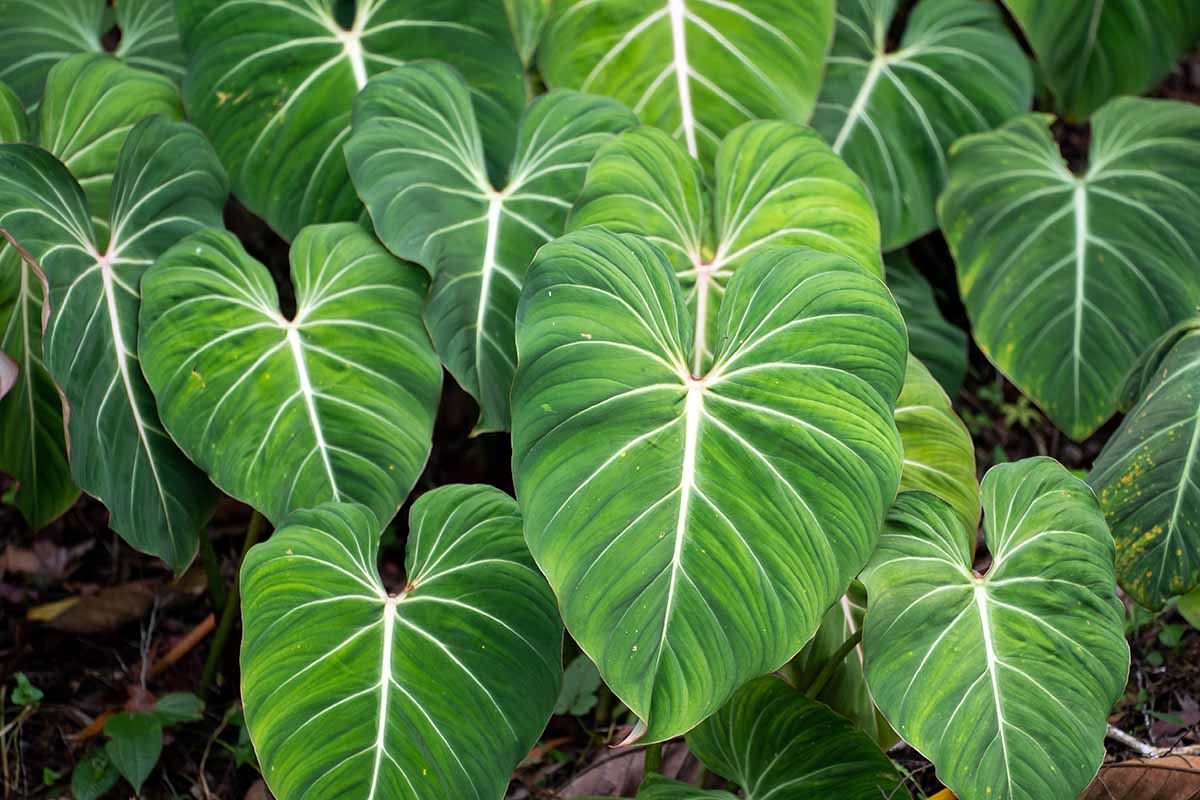
We link to vendors to help you find relevant products. If you buy from one of our links, we may earn a commission.
If you’re having trouble narrowing down which of the dozens of different types of philodendrons on the market you should add to your collection, I get it.
I started with a sweet little heart-leaf, and the next thing I knew, I was shelling out far more than I should for unusual hybrids and hard-to-find cultivars.
Whether you want help choosing one or you’re curious about the options out there, this guide will explore 41 of the most interesting, adaptable, accessible options.
Here’s the lineup:
41 of the Best Philodendron Varieties
Plants in the Philodendron genus fall into two categories: climbing and non-climbing, also known as vining and self-heading.
They can also be grouped as epiphytes, hemiepiphytes, or terrestrial. Epiphytes grow attached to trees or bushes. Terrestrial types grow in the soil.
Hemi-epiphytes grow both in the soil and attached to trees. Generally, we can grow all three in the same way, though epiphytic types can be mounted.
Be sure to check out our guide to growing philodendrons to learn more about growing these easy-care plants.
In general, most philodendrons prefer somewhat bright to bright, indirect light and a moderate amount of water. The pot should be allowed to dry out by about halfway before you add more water.
We’ll let you know if any of the varieties in this list have different requirements.
1. Atom
‘Atom,’ sometimes called ‘Super Atom,’ has dark green glossy leaves and an upright growth habit. It has thick, light green veins and as the leaf ages, the margins become lobed.
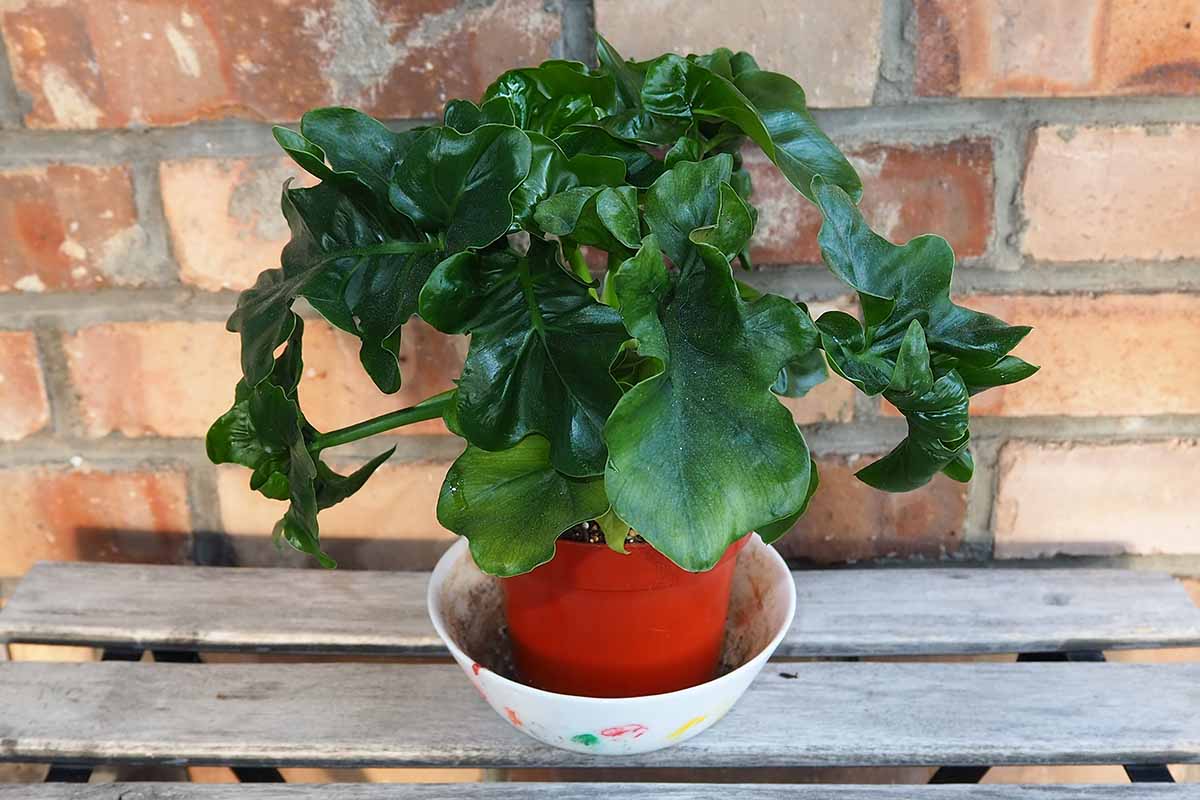
It’s often mistaken for P. selloum when mature, and you’ll often see it mislabeled as that plant.
This is actually a dwarf cultivar of P. bipinnatifidum (syn. Thaumatophyllum bipinnatifidum) that grows to about three feet tall and wide.
If you’d like to check out this rising star, you can find a live plant in a four-inch pot available from California Tropicals via Amazon.
2. Billie
The foliage on P. billietiae, sometimes just called Billie, looks like someone took a green heart and stretched it out from top to bottom.
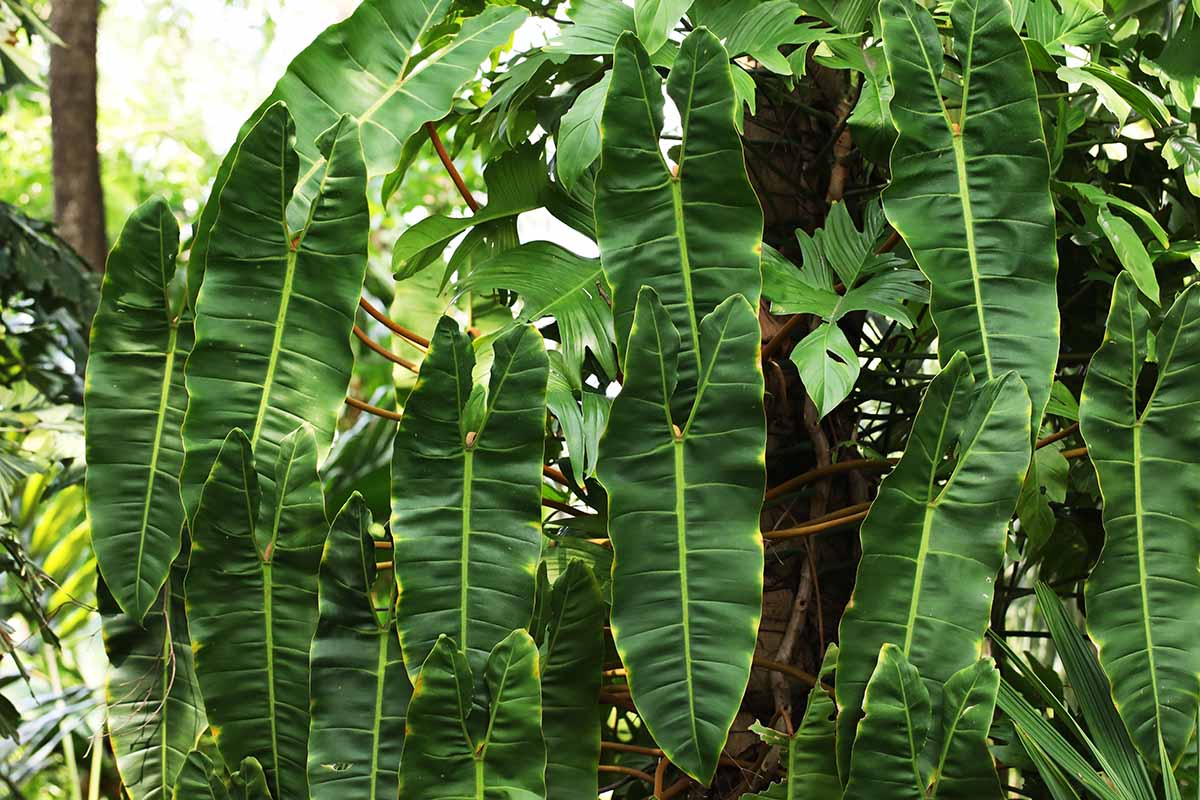
The leaves can be up to a foot long on a plant that reaches about four feet tall when mature. P. billietiae is native to Brazil, French Guiana, and Guyana.
The dark green leaves on this climbing type are so glossy that they almost look like they’re wet. Combined with the wavy leaf margins, bright green mid-veins, and yellow-orange petioles, it’s a stand-out.
There are both solid and variegated cultivars available, but the species plant is pretty phenomenal.
3. Birkin
A lot of philodendrons grow rapidly, outgrowing their pots or taking over the area where you plant them within a few years. But the upright ‘Birkin’ takes its time to reach its mature height of just under three feet.
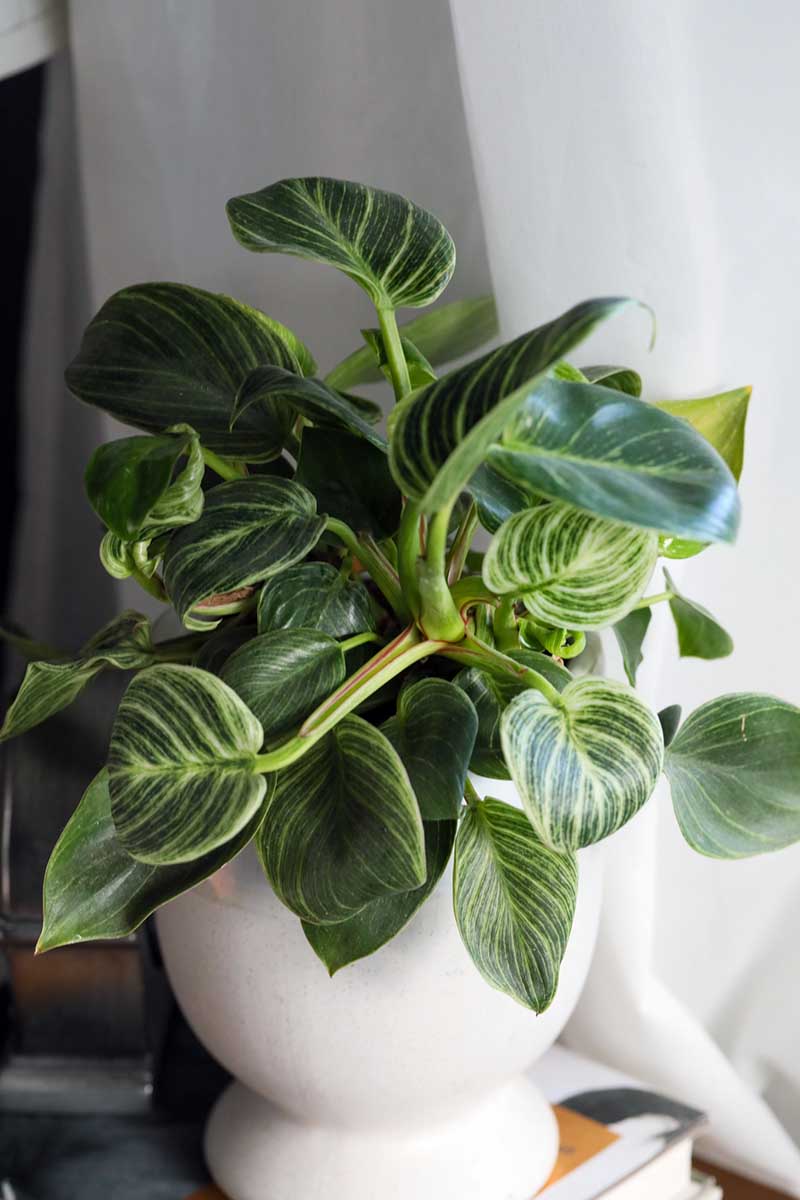
This natural chimera of Philodendron ‘Rojo Congo’ came from Florida in the early 90s and has heart-shaped green leaves striped in cream or yellow.
‘Birkin’ is like the plant version of a pinstriped suit with its varying stripes, and it’s guaranteed to draw the eye wherever you keep it.
Visit Fast Growing Trees to pick up a live plant in a six-inch or gallon-sized container.
4. Black-Gold
P. melanochrysum aka black-gold philodendron is a lesser-known species, and one that will always cause a stir.
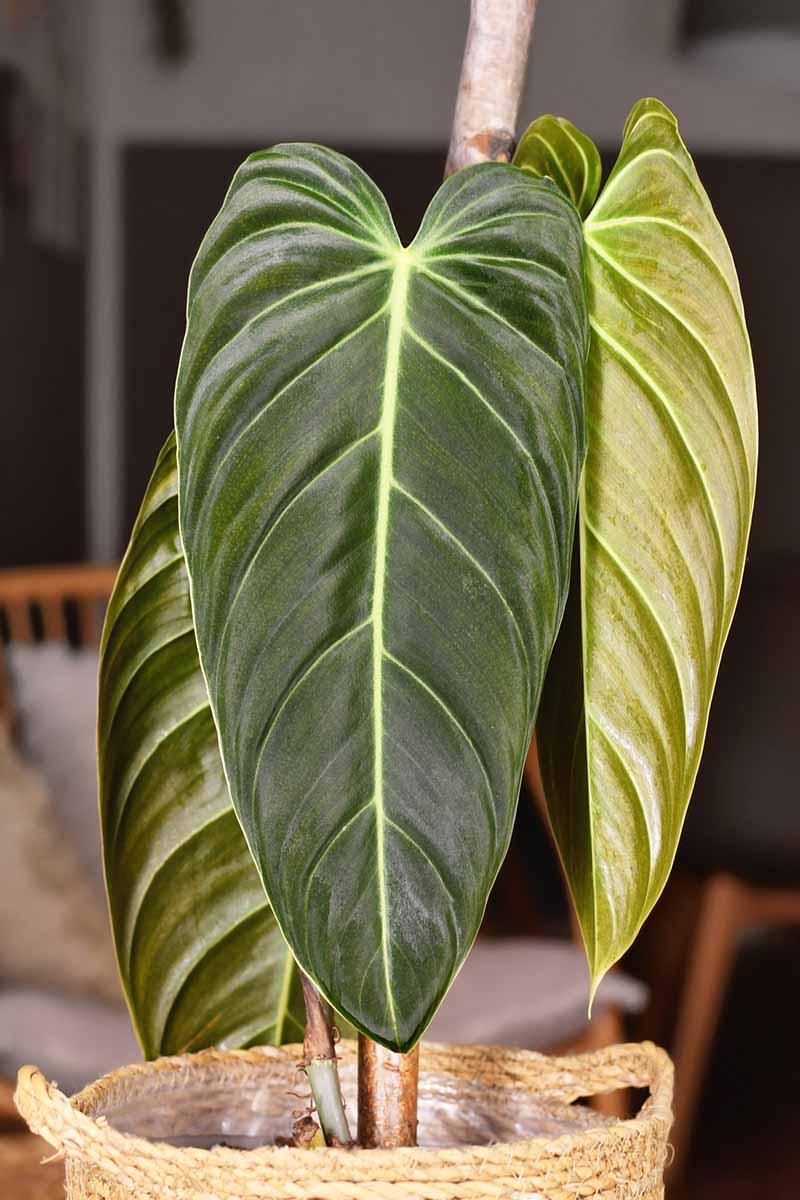
The dark green and brown-hued leaves have golden veins and a striking velvety texture, and each can grow up to two feet long.
The plant can grow over 25 feet tall in its natural habitat, though it typically stays under six feet when cultivated indoors.
The hardest part is getting your hands on this climbing South American native since it’s fairly uncommon, but once you do, it’s easy to grow.

Pop on over to Amazon to snag a cute little starter plant in a four-inch pot from BubbleBlooms.
5. Black Cardinal
‘Black Cardinal’ is a P. erubescens cultivar that will thrill anyone who loves the gothic aesthetic.
I count myself among that group. I love dark red, deep purple, or black plants because they’re uncommon in nature.
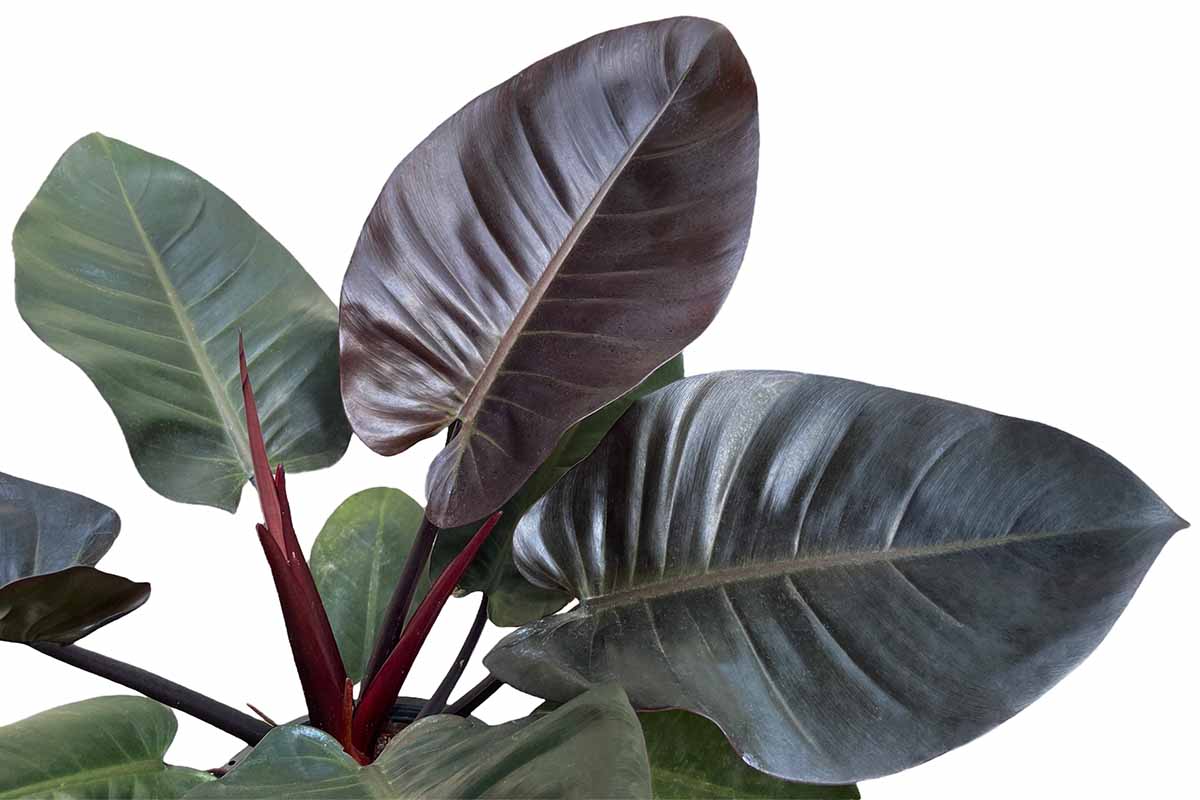
Both extremely dark and extremely light plants are at an evolutionary disadvantage, so we don’t see them much in the wild. That makes them all the more interesting, in my eyes.
Of course, this upright plant isn’t pure black. Few species are.
Instead, it has dark green leaves with deep red undersides. The young leaves are bronze in color. Once the plant reaches its mature indoor height of around five feet, it’s an impressive sight.
You can find live plants in four-inch pots available from Mini Garden via Amazon.
6. Brandi
P. brandtianum aka brandi is a climbing epiphyte indigenous to Colombia, northern Brazil, and Bolivia in areas where it’s dry for at least part of the year. That means this species will tolerate dry soil more than others.
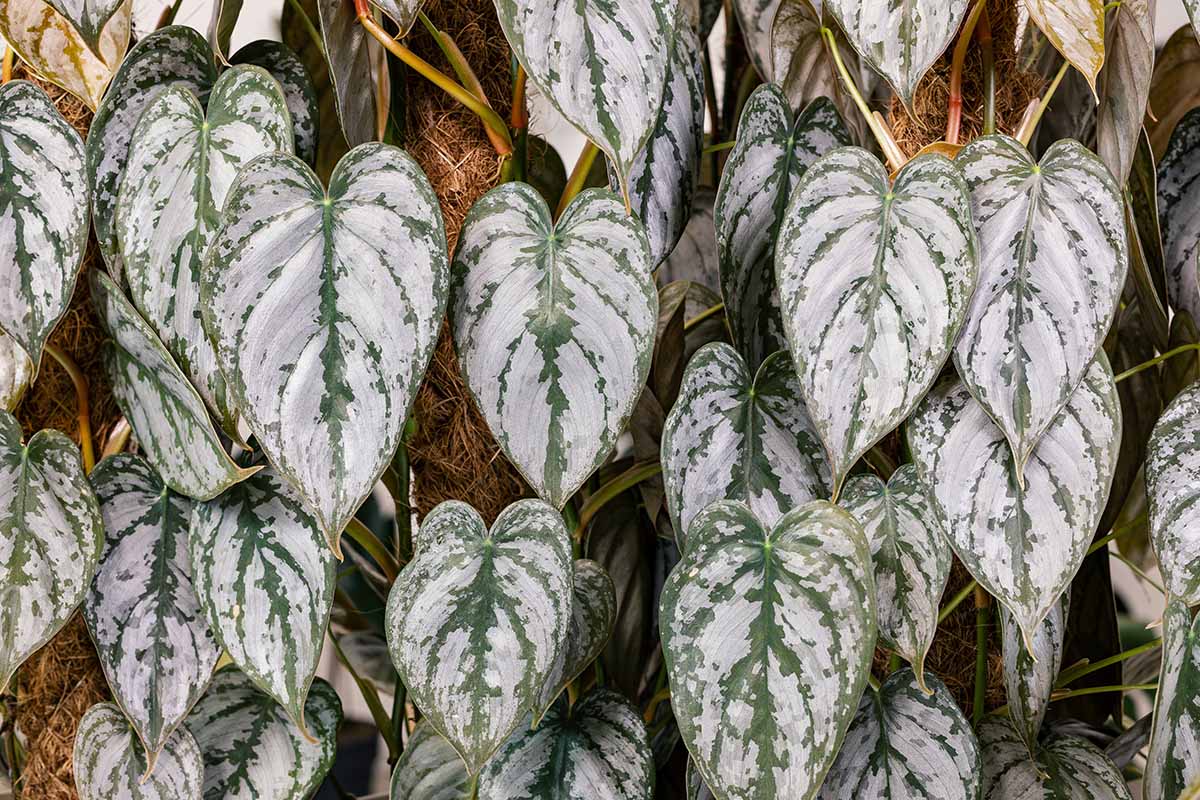
This climber can easily reach 15 in length indoors and even longer outside, and it’s often confused with satin pothos (Scindapsus pictus), which isn’t a true pothos.
Brandi and satin pothos both have green heart-shaped leaves with grayish variegation, though the latter has more of a shimmery silver hue and the leaves on brandi are a bit more elongated.

Find a live plant in a six-inch pot at the BubbleBlooms store via Amazon.
7. Brasil
A heart-leaf (P. hederaceum) cultivar, ‘Brasil’ takes the charming leaf shape of the species and adds lemon and lime variegation.
It’s fairly new on the market but it has already become wildly popular.

‘Brasil’ is a mutation of the species that was identified by Ruben Ernesto Acosta in Holambra, Brazil, in 1991.
It was further stabilized and patented in 2000 by Kerry’s Bromeliad Nursery in Florida.
Native to South America and the Caribbean, ‘Brasil’ is an epiphyte that wraps itself up trees.
In the wild, you’ll find it stretching up to 10 feet or more, but indoors it stays a more modest three or four feet.

You can find ‘Brasil’ available in a six-inch pot from the American Plant Exchange via Amazon.
Learn more about how to grow Philodendron ‘Brasil’ in our guide.
8. Burgundy Princess
When a ‘Pink Princess’ has little variegation, it’s sold as the beautiful ‘Burgundy Princess.’
They’re the same cultivar, but since neither has been stabilized, they can have little or no variegation or tons of it. That’s the only thing that separates the two.

The leaves of this plant have low variegation with dark green and burgundy hues and rarely any pink, but be aware that it can spontaneously start growing more heavily variegated foliage with pink coloration.
If you don’t like it, you can trim off any pink leaves that pop up to maintain its burgundy and green hues. Or you can allow the pink to develop and you’ll eventually have a ‘Pink Princess.’
This plant has an upright habit, so instead of allowing it to trail out of a pot, offer it a moss pole or something to climb up so it can reach its full five feet tall and show off those five-inch leaves.
Grab this P. erubescens cultivar in a four-inch pot from California Tropicals via Amazon.
9. Burle Marx
P. burle-marxii hails from Columbia, Ecuador, and Brazil, where it climbs up other plants, showing its glossy, cordate green leaves to the best advantage.
There is also a variegated version with yellow, white, and green foliage.
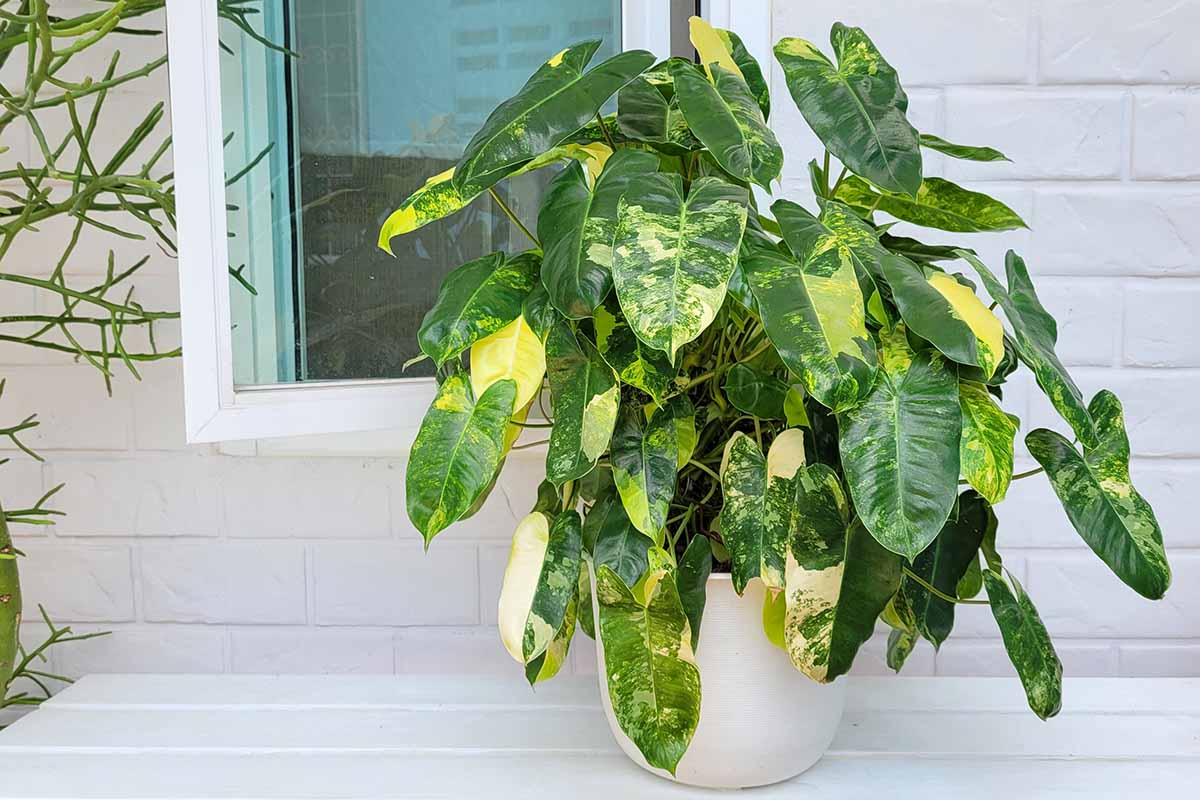
It’s named after the prolific landscape architect from Brazil, Roberto Burle Marx.
This upright plant is easygoing and adaptable, perfect for the new houseplant grower, eventually becoming an attractive three-foot tall plant.
You can find one in a decorative eight-inch pot available at Home Depot.
Or grab a small variegated starter plant from Amazon.
10. Congo Green
‘Congo Green’ is a hybrid with glossy dark green elongated leaves with prominent veins and reddish petioles. We aren’t sure of its parentage but it likely has ‘Imperial Red’ in its background.
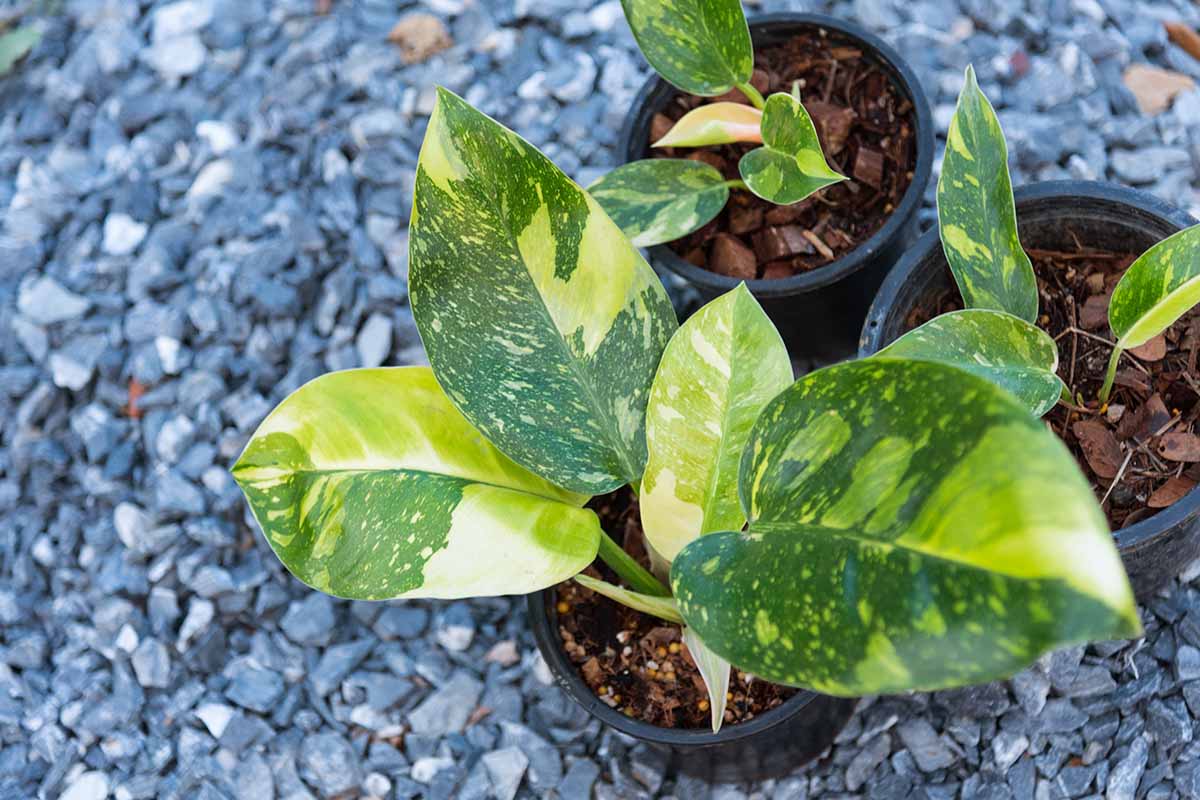
It’s an upright type with arrow-shaped leaves that can grow extremely large at up to 16 inches long and a foot wide on a plant that can grow six feet tall or more.
It’s similar to ‘Rojo Congo’ but with a larger stature. There’s also a rare variegated version.
Head over to Amazon to find a live plant in a four-inch pot from California Tropicals.
11. El Choco Red
P. rubrijuvenile ‘El Choco Red’ isn’t easy to find, but it’s well worth seeking out.
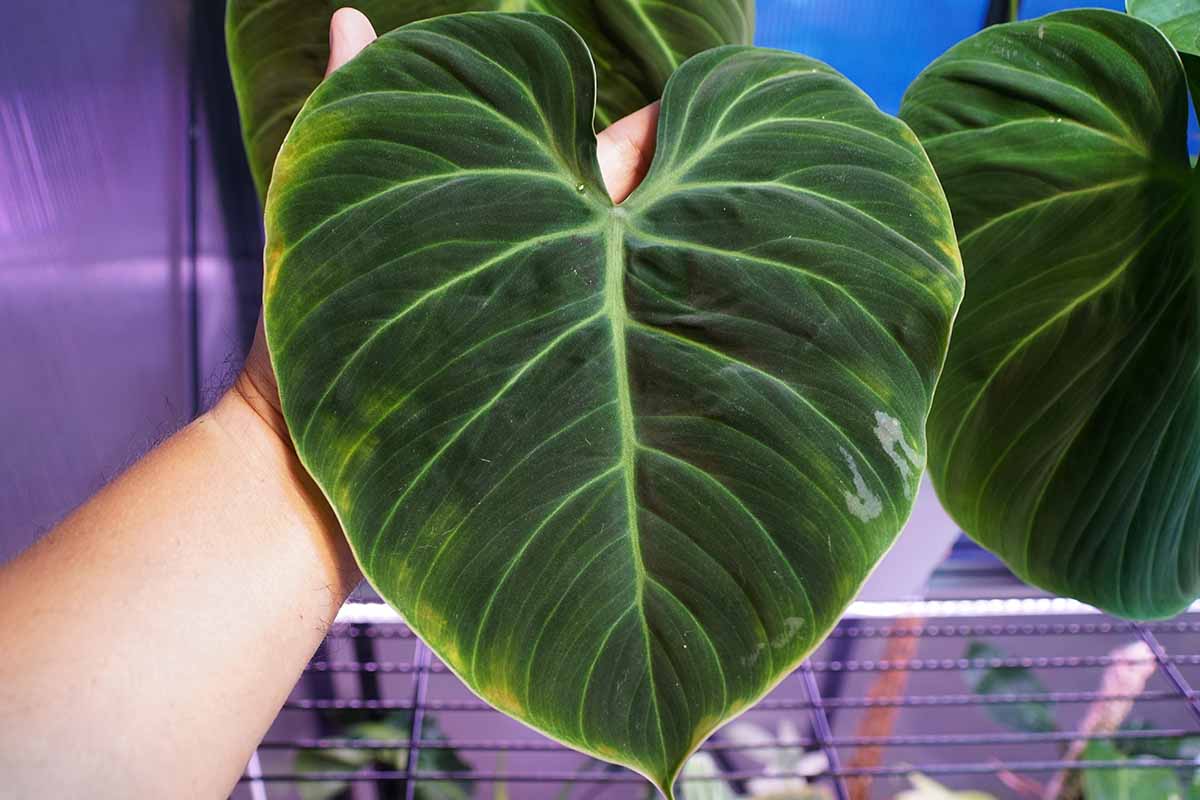
Featuring heart-shaped leaves with a velvety texture, the “red” in the name refers to the bright red coloration on the undersides of young leaves.
As the leaves mature, the undersides turn light green, contrasting with the darker green surfaces.
It makes for a beautiful display once it climbs to its full four or so feet tall.
12. Elephant Ear
If you’re looking for a plant that makes a huge statement, choose P. giganteum, commonly known as elephant ear philodendron.

The glossy, heart-shaped foliage can grow up to two feet long on a self-heading plant that can grow up to 20 feet tall outdoors, topping out at eight or more when grown indoors.
The prominent veins cause wavy margins that stand out dramatically, even more so on the variegated variety.
13. Emerald Red
The beautiful glossy leaves of the climbing P. erubescens ‘Emerald Red,’ sometimes called blushing philodendron, are emerald green on top and lime green underneath, attached to the stem by burgundy petioles.
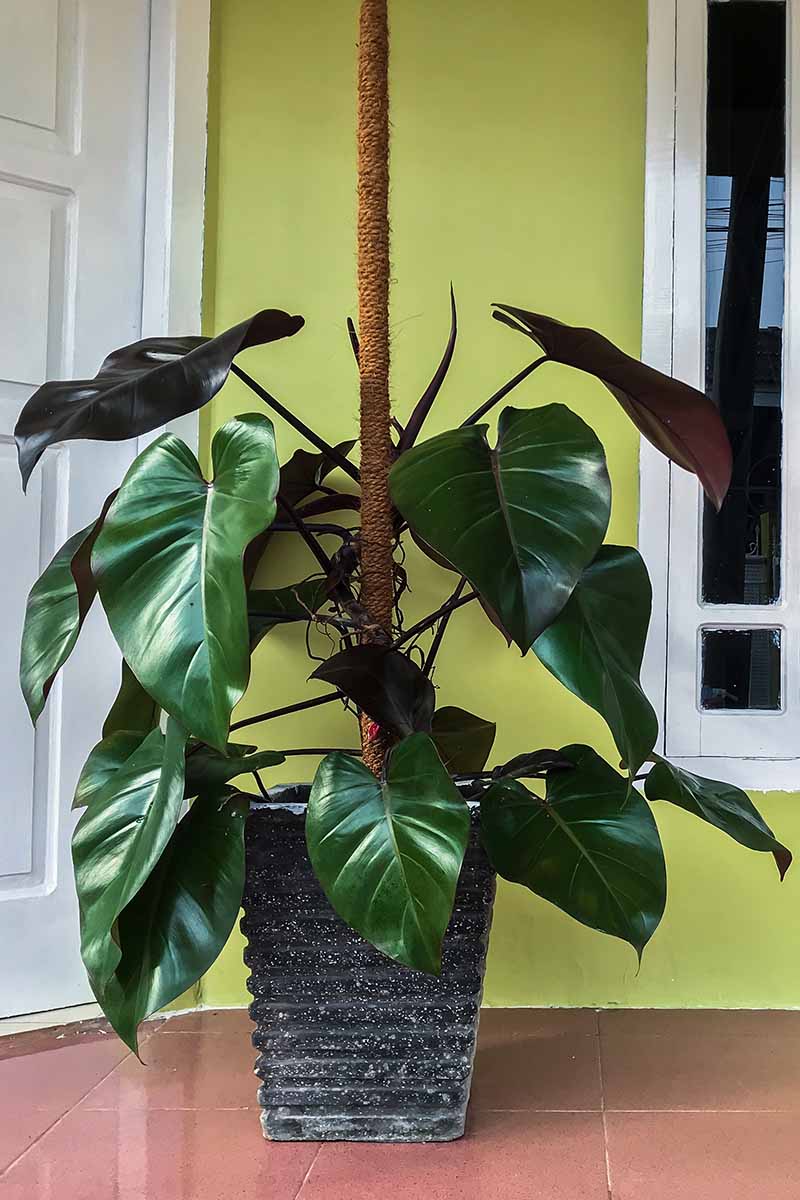
When the plant is mature, it grows to about three or four feet tall and twice that outside.
Variegated forms are known as ‘Strawberry Shake.’ These cultivars are the same species but the coloration is unstable and ‘Emerald Red’ lacks the pink variegation, so growers sell them under different names.
You can find live four-inch plants available from California Tropicals via Amazon.
14. Florida Beauty
A hybrid cross between P. squamiferum and P. pedatum, ‘Florida Beauty’ is everything you’d expect of a tropical stunner.
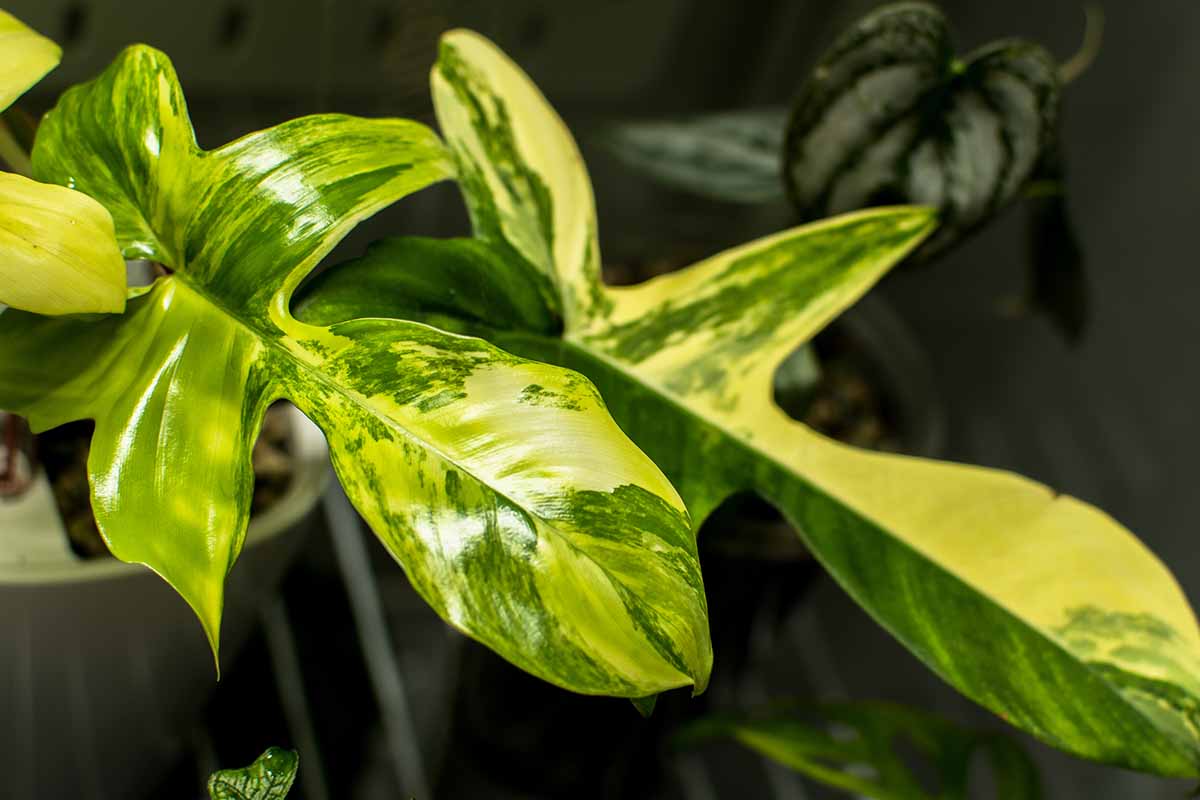
This climber stretches up to 12 feet indoors, with masses of huge, deeply-lobed, heart-shaped leaves, each with five “fingers.”
The foliage is dramatically variegated, with hues of cream, white, and green.

If you want to bring some of this beauty home to your space, you’ll find live plants in four-inch pots available from California Tropicals via Amazon.
When the plant lacks the variegation, it’s sold under the name ‘Florida Green.’
This is a unique cultivar that tends to stay smaller than its variegated friend, but they are identical otherwise.
You can find ‘Florida Green’ in a four-inch pot at the BubbleBlooms store via Amazon.
15. Gloriosum
P. gloriosum tops my list of favorite houseplants. The leaves are huge – up to three feet long – with the most intense blue-green hue and a velvety, iridescent look.
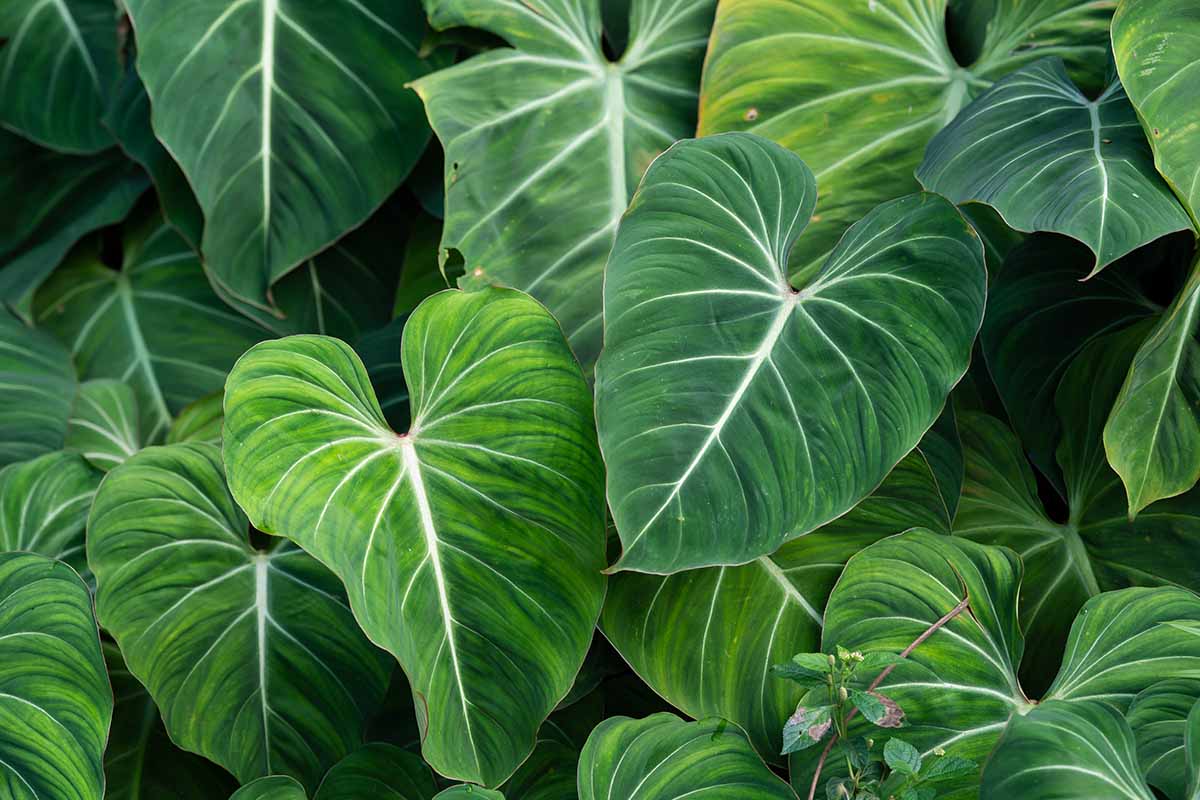
That would be enough to make it stand out, but the distinctly heart-shaped leaves have prominent veins in a light green-to-white hue, often with a pale red blush, making it all the more arresting.
This self-heading type can grow up to five feet tall or more.
It was the first rare plant that I ever bought and I paid an exorbitant amount for a tiny starter plant.
Fortunately, it is easier to find and less expensive these days. Walmart carries a starter plant in a two-inch pot.
16. Golden Dragon
Gorgeous ‘Golden Dragon’ doesn’t whisper, it roars. It has huge leaves that can grow up to two feet long and a foot wide, with an unusual shape.
The leaves are hierarchically lobed, with the center lobe being much longer than the other four lobes. The plant itself can reach up to five feet tall.

The young leaves on this climbing type are mottled with golden yellow and gradually become dark, solid green when mature.
It was bred in Thailand using P. bipennifolium and a second, unknown parent, and there are also variegated cultivars such as P. x ‘Golden Dragon Variegata,’ with bright yellow to cream spots.
17. Hairy
P. squamiferum, also known as hairy philodendron, has heavily lobed leaves, each with five rounded lobes, that can grow up to a foot long.
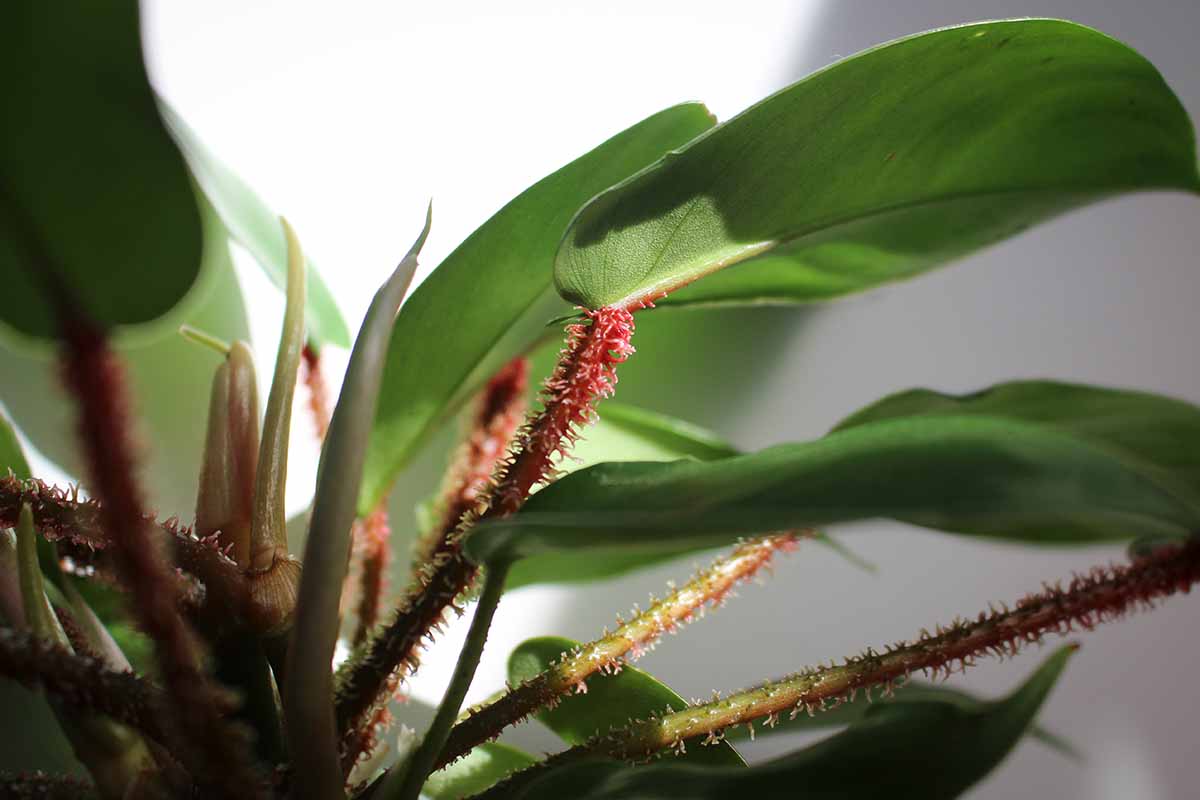
While the glossy olive green leaves are lovely, this species stands out from most other philodendrons because of its fuzzy red petioles.
In the wild, you’ll find it in French Guiana, Suriname, northern Brazil, Ecuador, Colombia, Venezuela, and Peru.
Since it’s a vining type, it twines its way up trees and supports and grows up to 15 feet long.

You can find hairy philodendron available in three-inch pots via Amazon.
18. Heart-Leaf
Heart-leaf philodendron is often one of the first that people grow when they’re new to the genus. They’re adaptable and beautiful, with long vines packed with glossy heart-shaped leaves.
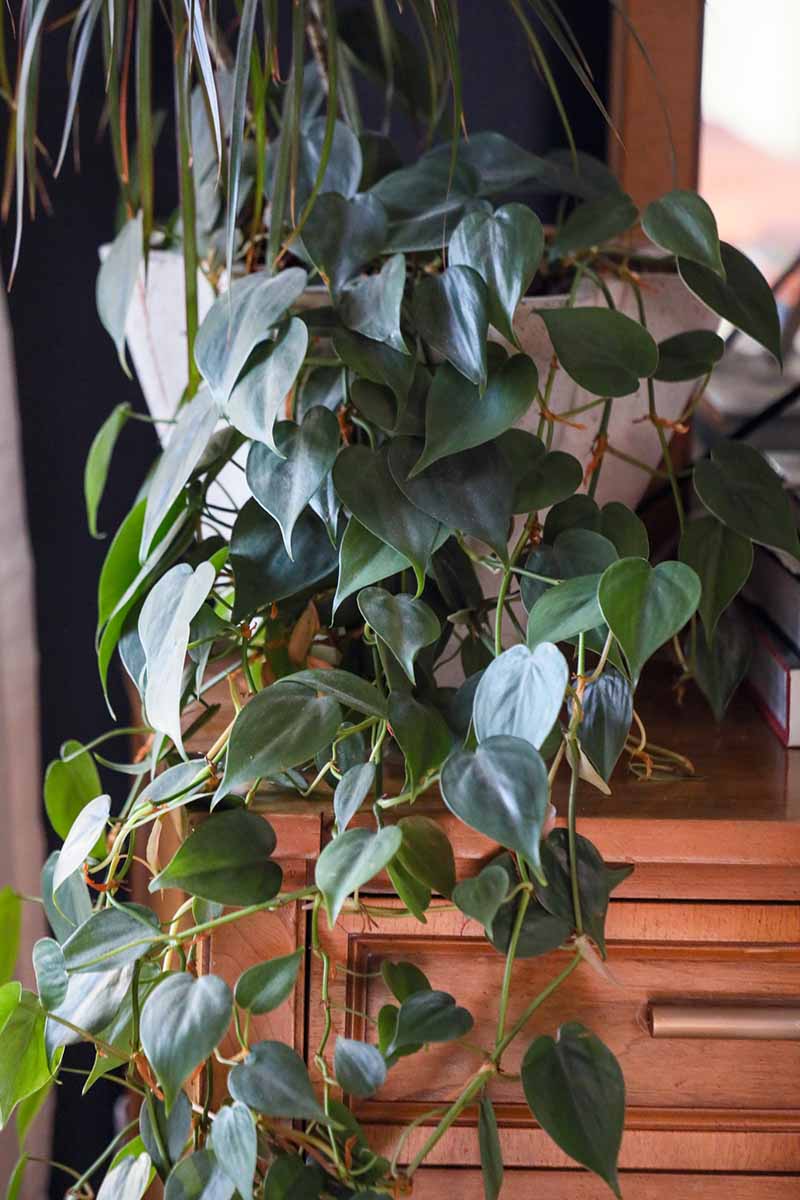
These plants are often mistaken for pothos vine, but the leaves on heart-leaf are distinctly heart-shaped compared to the more elongated shape of pothos.
Native to the Caribbean and South America P. hederaceum (often mislabeled as. P. cordatum) is the parent of many beautiful hybrids and propagates easily.
The vines on this climbing type grow up to six feet long indoors.
You can find heart-leaf philodendrons available in six-inch pots at Fast Growing Trees.
19. Imperial Red
We don’t know how this hybrid came to be, but it’s wildly popular these days.
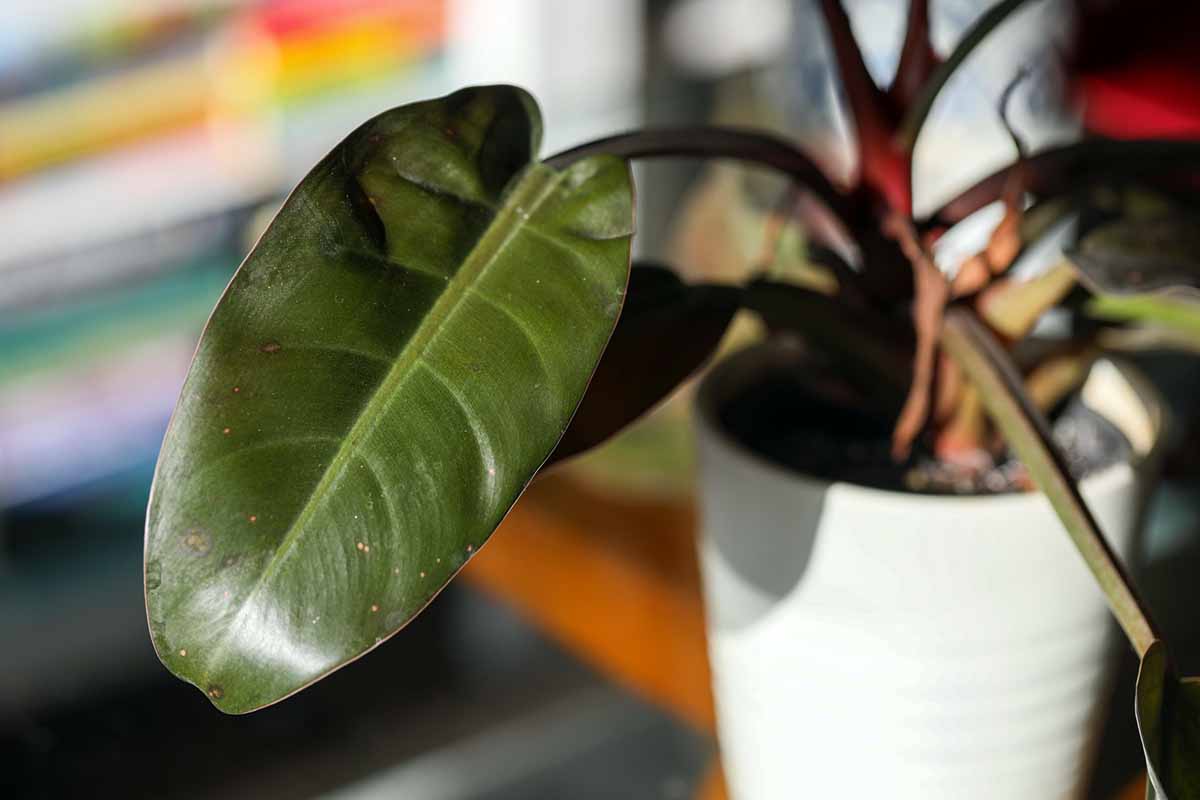
It hasn’t been around that long as it hit the market within the past 20 years, but we know this self-heading type has at least some P. erubescens in its lineage.
The large, elliptic leaves range from dark green to burgundy, with shades of blush and red in between. The stems are red and green.
The plants lose their color in too much or too little light, so try to keep them in the bright, indirect light that most philodendrons prefer.
If you do, it can grow up to three feet tall indoors and it is a self-heading type.
You can find this striking option in four-inch pots available from Californian Tropicals via Amazon.
20. Lemon Lime
A cultivar of P. cordatum, this beautiful plant is like a highlighter for your home.
The young leaves have a hint of blush as they emerge, but they mature into bright yellow or chartreuse, each with a perfect heart shape.
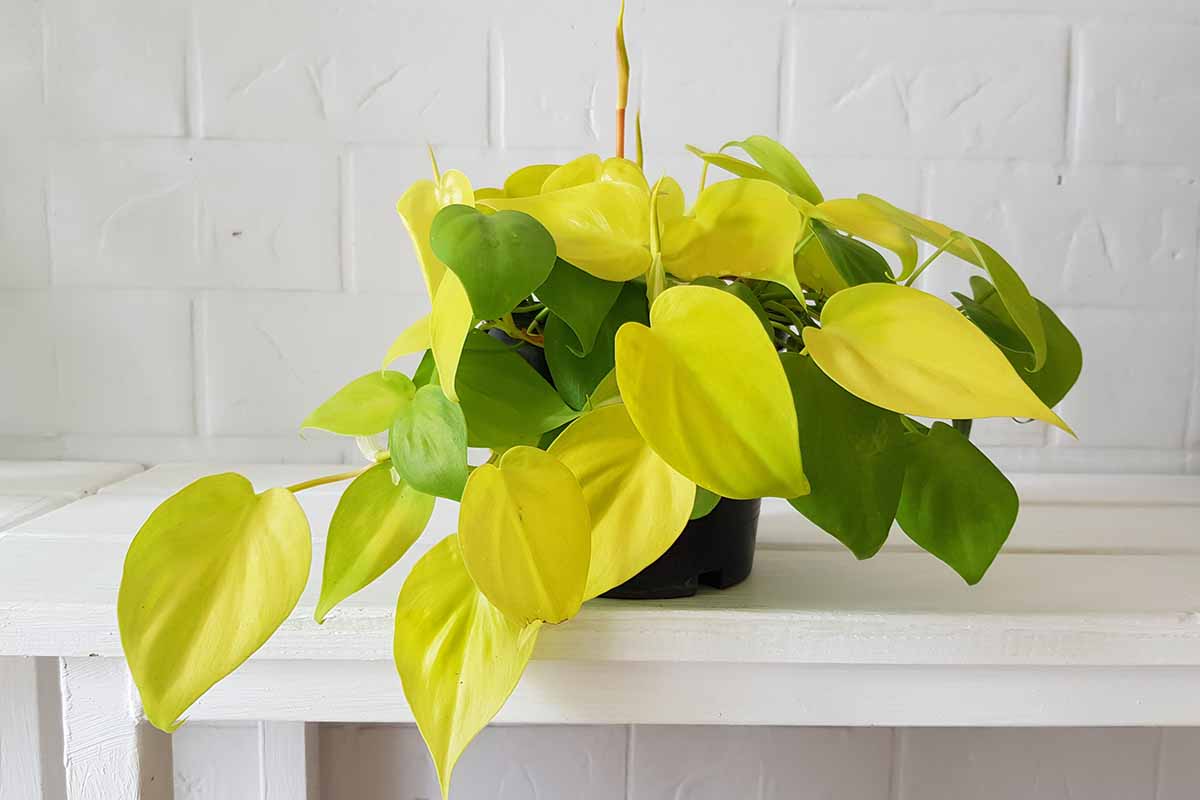
This isn’t a variegated cultivar, though there are variegated heart-leaf cultivars out there.
The leaves are solid on vines that can grow up to six feet long, but they change as they age.
Since the various leaves on a single plant are all of different ages, the effect is that of multiple colors on one plant.
Highlight your space and grab a young plant in a four-inch container from California Tropicals via Amazon.
21. Luxurians
P. luxurians is a show-stopper with deep green leaves highlighted by pale green veins with fuzzy margins that look like they’ve been painted on like a watercolor.
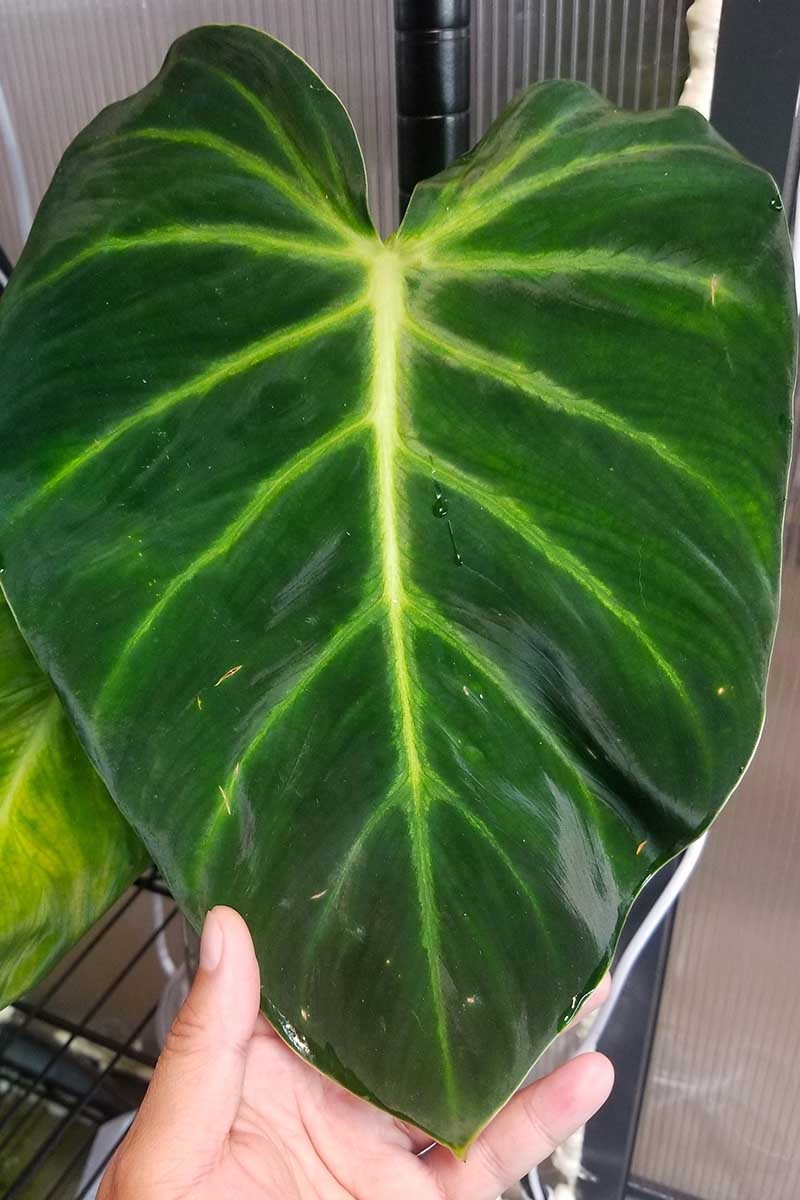
The foliage looks similar to that of P. gloriosum except the leaves are glossy instead of velvety.
The heart-shaped leaves are large, up to nine inches long, on a self-heading plant that reaches two feet tall.

Hop on over to Amazon if you want to bring home a live plant that will make a dramatic statement.
22. Mamei
With huge, heart-shaped green foliage with silver splotches, and deeply folded, pinstripe-like veins, P. mamei is a unique specimen.
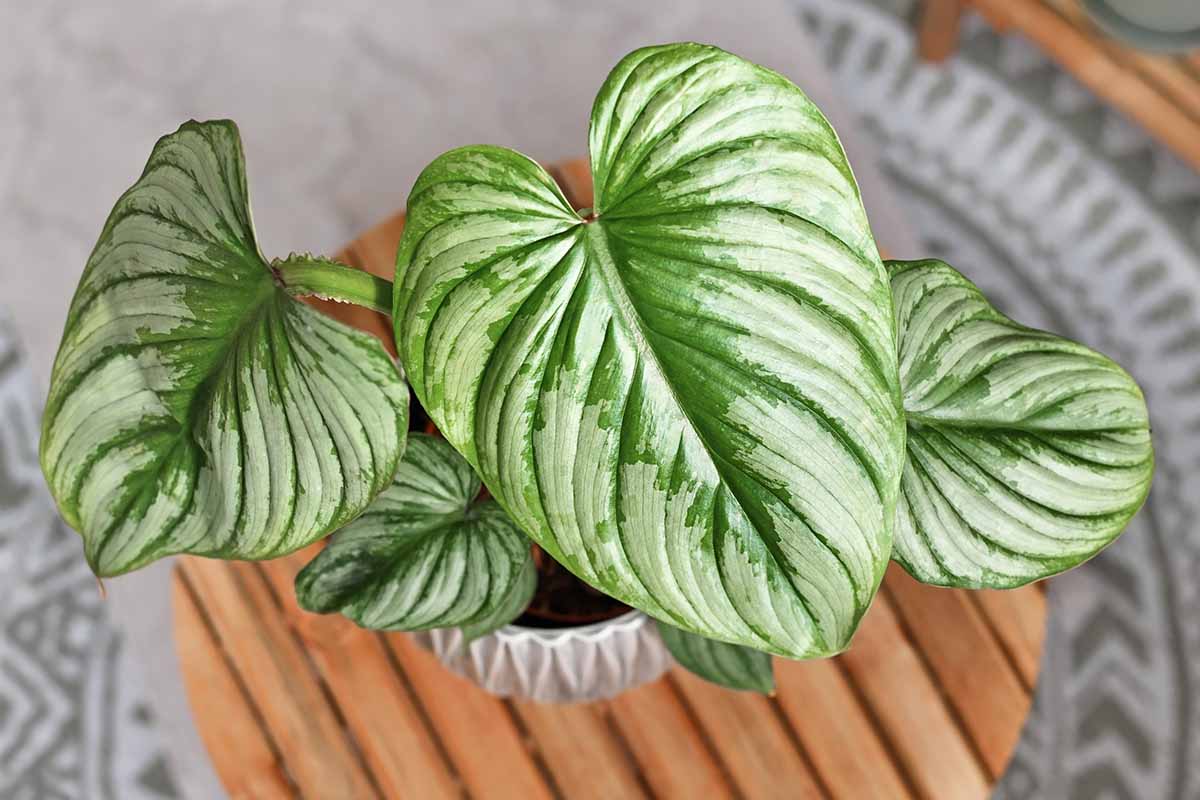
This self-heading type likes it hot, which is unsurprising given that it hails from the hot rainforests of Peru and Ecuador. Perfect for a warm area of your home, though it adapts to cooler temperatures.
If you’ve got the philo bug, this is a must-have addition.
Even if you don’t have the bug, it’s a dramatic houseplant option, whether it’s your sole addition or one of many, especially when it reaches its full height of around 40 inches.
Visit Walmart to purchase a live plant in a six-inch pot.
23. McColley’s Finale
With long lanceolate leaves on a self-heading plant, this beauty calls attention to itself with the young chestnut-red leaves that gradually mature to medium green with chestnut-red accents.
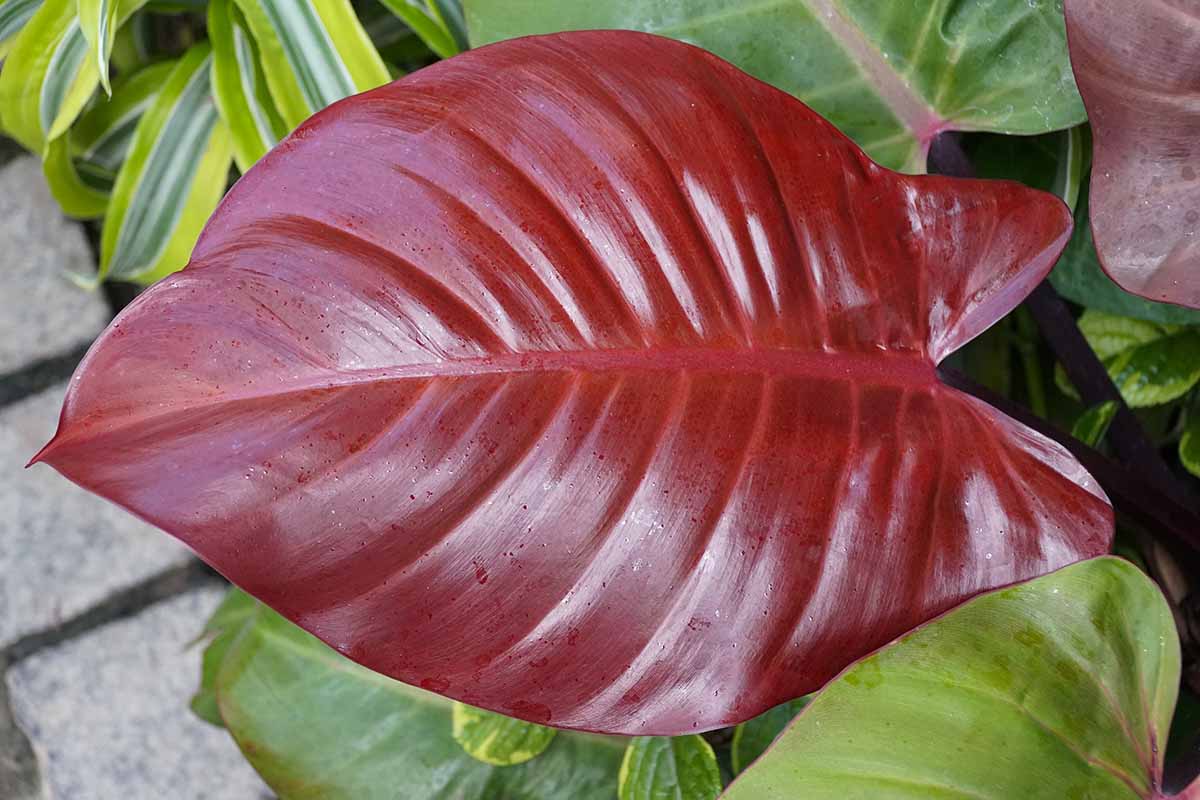
Bred by Bob McColley, owner of Bamboo Nurseries in Orlando, Florida, ‘McColley’s Finale’ was registered by his wife Cora in 1999 after he passed.
It’s unclear what species McColley used to breed the plant, but after his death his wife came across it and instantly recognized that this was something special with its unique coloration.
Unlike some philodendrons, which lose their color in the wrong light, ‘McColley’s Finale’ holds its color even in too little or too much light – within reason, of course. At three feet tall indoors, it’s the perfect height to work as an accent.

Punctuate any space with a burst of enduring color by snagging ‘McColley’s Finale’ in a four-inch pot at Amazon.
24. McDowell
What happens when you cross P. pastazanum and P. gloriosum? The magnificent ‘McDowell’ (aka ‘Dean McDowell’).
It combines the massive heart-shaped and glossy-textured foliage of P. pastazanum with the prominent white veins and heavy wrinkling of P. gloriosum.
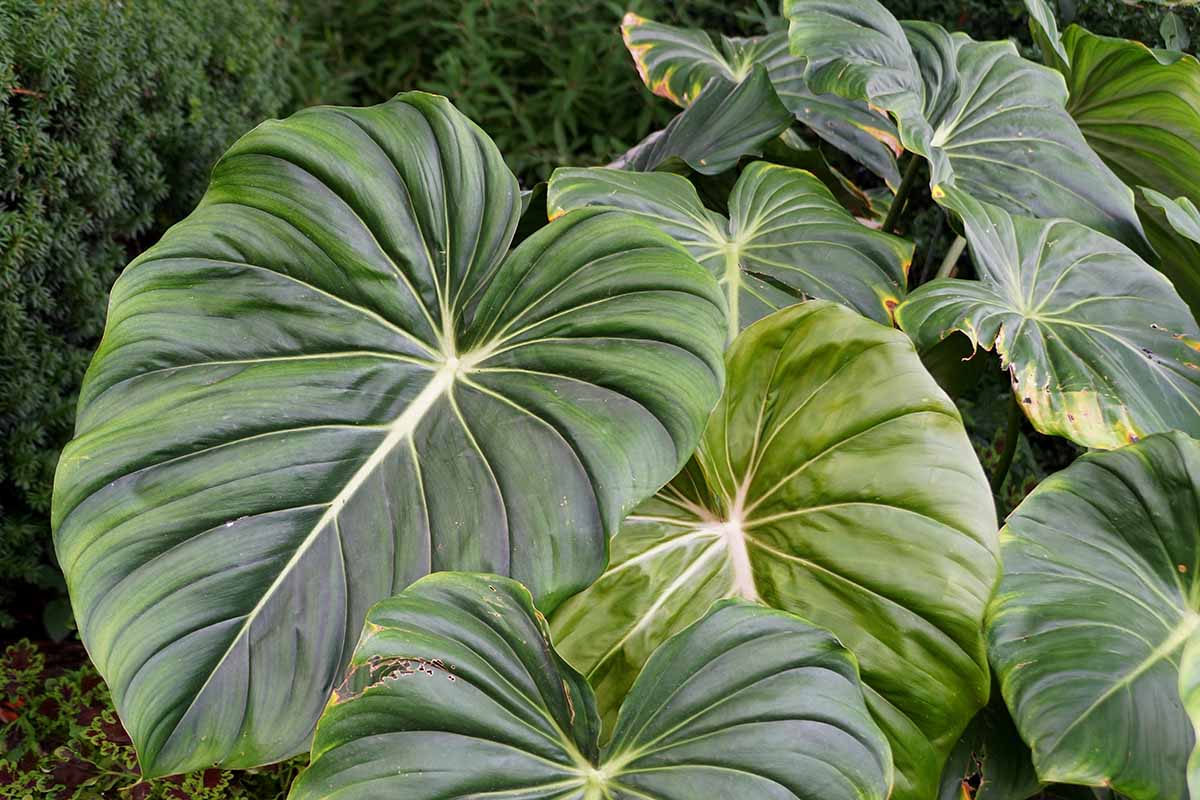
The self-heading plant can grow up to ten feet tall with leaves as long as three feet.
It was bred in 1988 by respected aroid breeder John Banta for his friend Dean McDowell, who passed away after a long battle with AIDS.
25. Mexicanum
With massive, glossy, tri-lobed leaves, P. mexicanum would be a dreamy philodendron even if it didn’t have bright green stems, but it does.
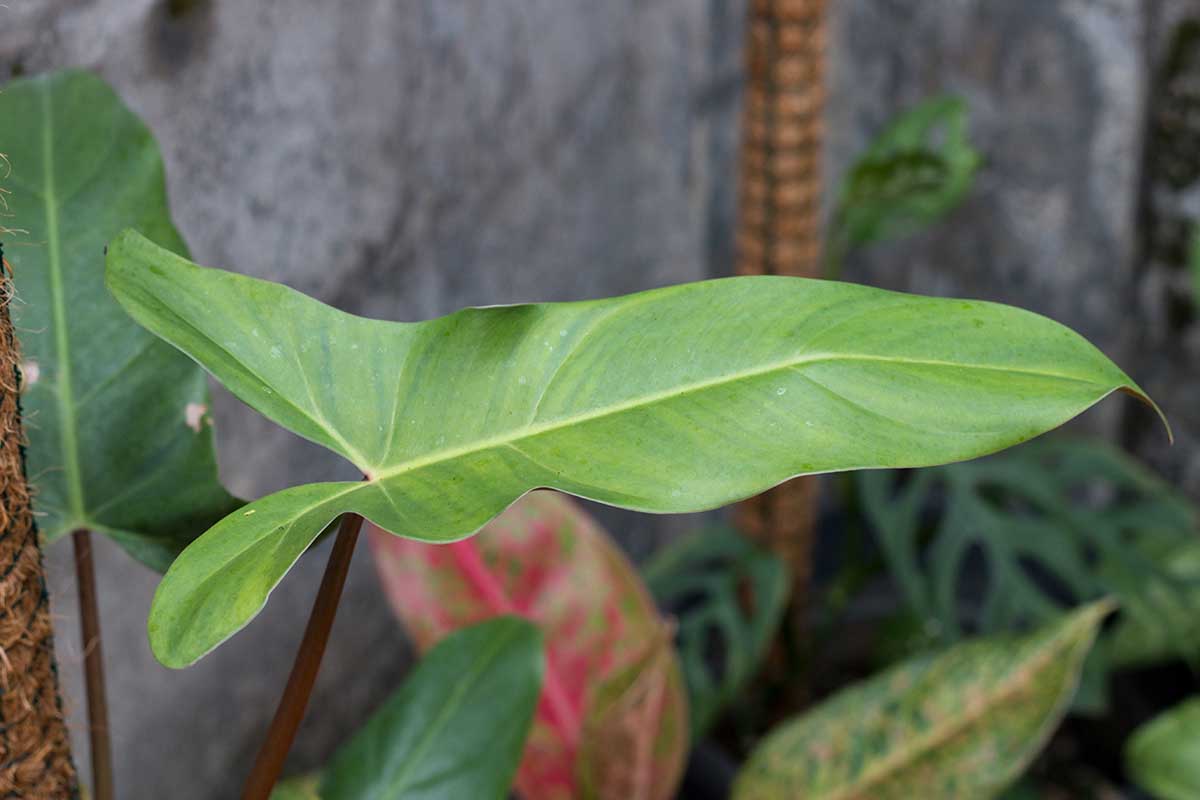
The young leaves emerge light green, but they gradually transition to dark green with maroon undersides.
Hailing from Mexico, P. mexicanum grows in drier climates than many other species, so let the medium just about dry out all the way before watering.
Invest in a heavy moss pole, because this climber will grow as tall as you let it, up to 20 feet, even indoors.
You can find starter plants in three-inch pots available via Walmart.
26. Micans
Philodendron hederaceum var. hederaceum is one of my favorite philodendrons.
It couldn’t be easier to care for, and it rewards your minimal efforts with heaps and heaps of vines covered in heart-shaped leaves that shimmer in the light.

The foliage has a velvety texture that appears dark green, copper, or purple, depending on the angle and the way the light falls. The undersides have a blush hue, as do the young leaves.
This Central American and Caribbean native is popular in the houseplant trade, no doubt in part because of its fuss-free nature.
It’s also exceptionally easy to propagate, so you can have one in every room if you wish. Left to their own devices, they can grow up to 20 feet outdoors but stay closer to 10 feet indoors.
You can find velvet leaf philodendron, as it’s also known, in four-inch pots available via Walmart.
And check out our guide to growing philodendron Micans here.
27. Moonlight
This self-heading hybrid looks like someone colored in the glossy ovate leaves with a yellow and green highlighter.

For the best color, provide the plant with direct light in the morning. The veins are a slightly lighter color than the leaves, and the stems have a faint blush hue when they’re young.
This hybrid will grow up to five feet tall inside. Sound like the thing to brighten up your space? Snag one, three or five plants in four-inch pots from Wekiva Foliage via Amazon.
28. Oak Leaf
I guess the leaves of oak leaf philodendron (P. pedatum) look a bit like oak leaves if you squint. But they’re much more interesting than that.
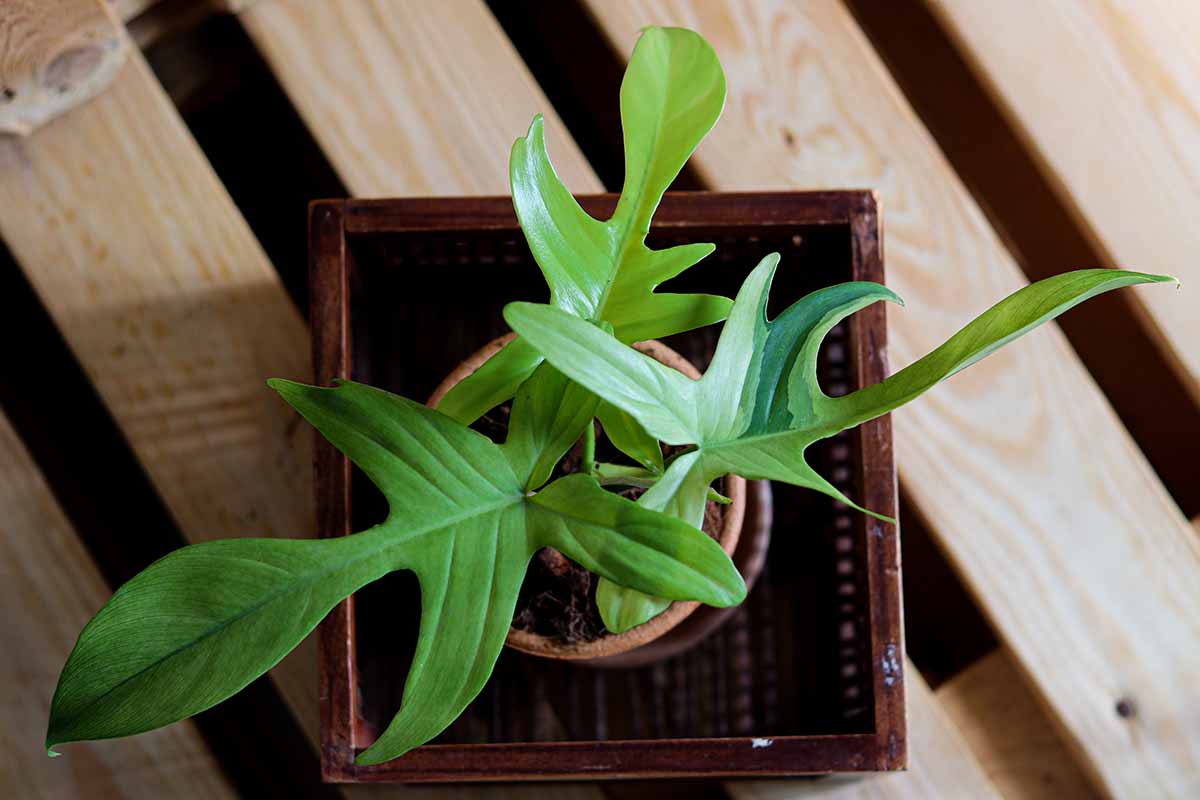
This South American native has deeply lobed leaves with five “fingers” when the leaves are young. The longest central finger is rounded and the other four are shorter and slightly pointed.
As the leaves age, they become more deeply divided and the lobes more pointed and elongated.
This self-heading type might remain juvenile in your home and never grow taller than about three feet tall, but with enough light and room, it can grow 10 feet or more.
Grab one in a four-inch pot from California Tropicals via Amazon.
29. Painted Lady
With yellow and green variegated leaves that look like they were carefully painted with splashes of watercolor, this hybrid was cultivated by the famous breeder Robert McColley using the P. erubescens cultivars ‘Burgundy’ and ‘Emerald Queen’ as parents.
You can see its lineage in the shape of its leaves and the burgundy stems.
The leaves emerge solid green, but don’t worry; they’ll gradually take on the elegant variegation.
Make sure it receives some direct light in the morning or the variegation will be less distinct.
Walmart carries ‘Painted Lady’ in four-inch containers.
Grab one of these self-heading plants and get ready to answer everyone who comes into your home and demands to know what that beautiful houseplant is.
30. Paraiso Verde
Whether you know this lady as green paradise, green princess, or ‘Paraiso Verde,’ it has deeply-lobed cordate leaves flecked in medium and dark green on a lime-green base.
Let this self-heading type climb up to 10 feet tall on a moss pole for an even more outsized display.
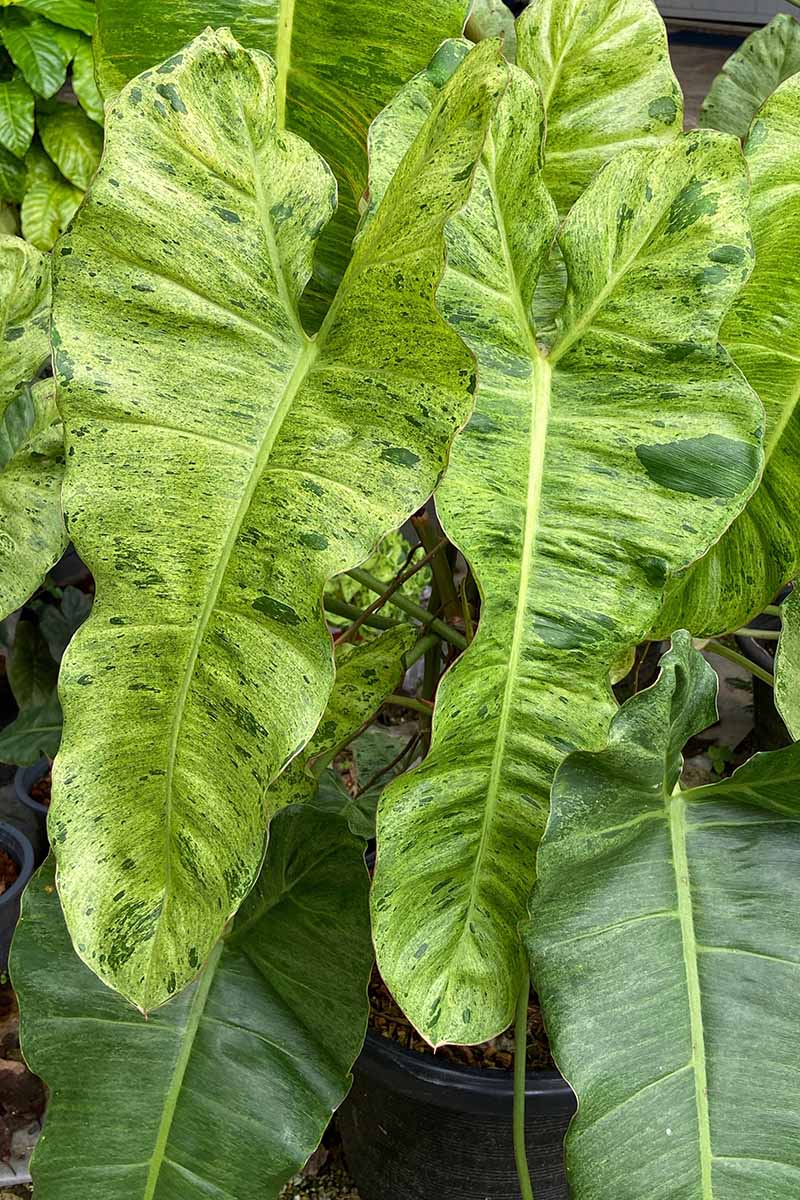
Don’t panic if some of the leaves start out solid green. The variegation is highly variable and it needs appropriate heat, moisture, and light exposure to look its best.
Keep the soil moist, the temperature above 65°F, and provide morning light, and you’ll be thrilled with the display.
This plant is a natural hybrid that was discovered in the forests of French Guiana in 2016 by nursery owner Natalino Correa of Belém, Brazil.
You can find four-inch starter plants available from BubbleBlooms via Amazon.
31. Pink Princess
‘Pink Princess’ is an extremely popular if pricey P. erubescens cultivar. If you ask philodendron lovers for a list of top ten of their favorites, this is likely one of them.
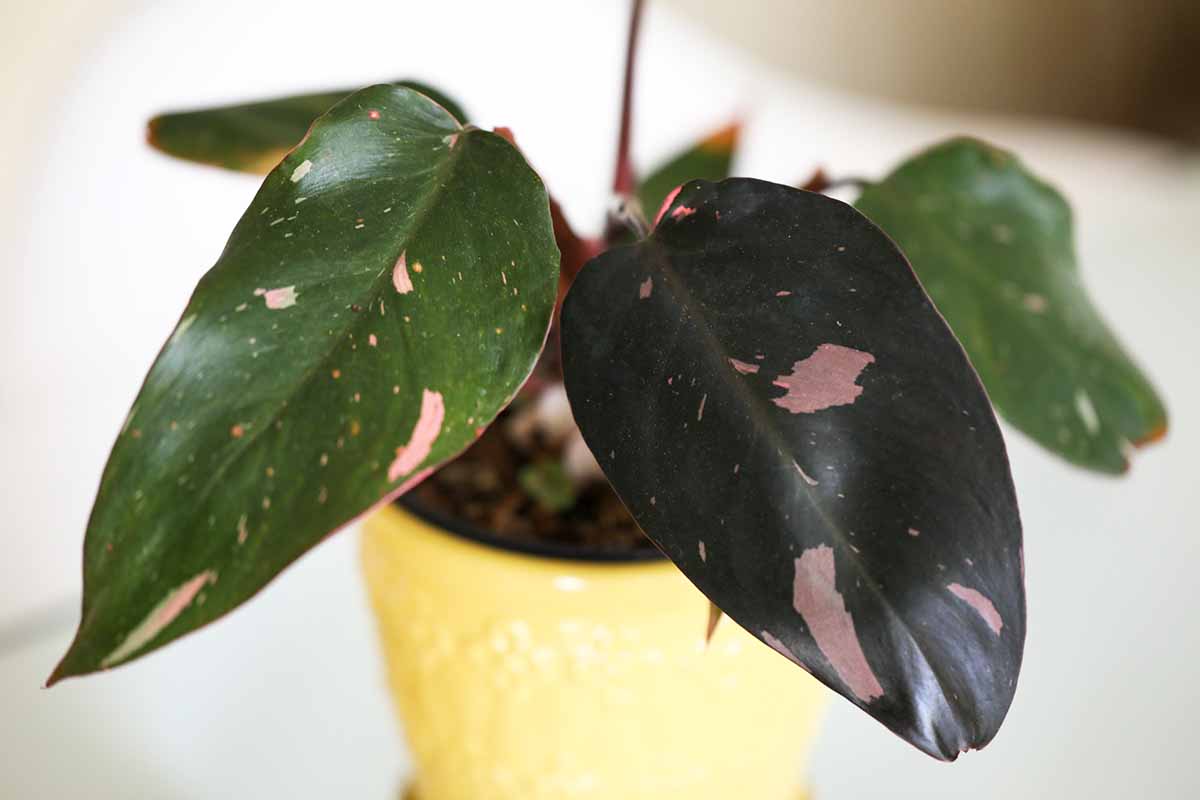
The leaves are heart-shaped with deep green, red, and true pink splotches with a stable variegation that is so distinct it looks positively fake.
The glossy leaves on this self-heading type can stretch up to five inches long on a plant that can be four feet tall.
Head to Fast Growing Trees to bring a plant in a gallon-sized container home for yourself or to make the philodendron lover in your life extremely happy.
32. Plowman
Plowman’s philodendron (P. plowmanii) is all about size and texture, rather than color – it doesn’t need to show off with bright hues to make a massive statement.
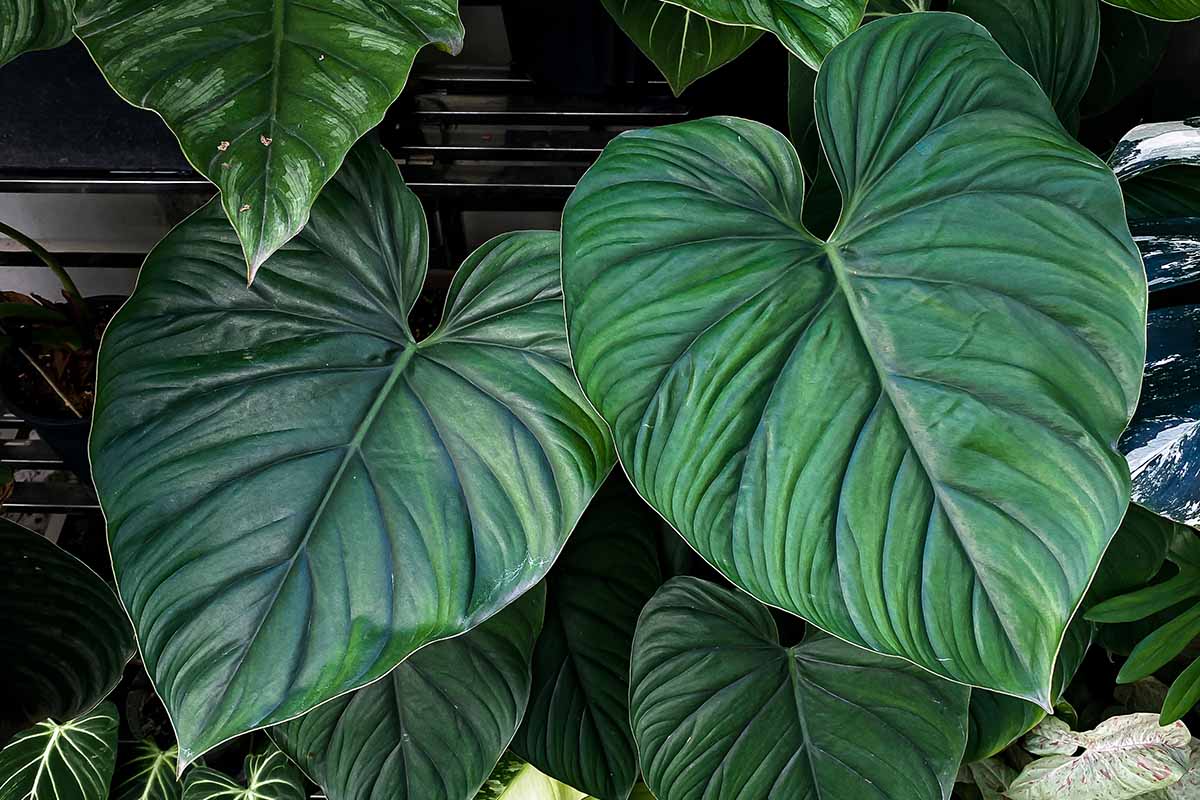
The huge heart-shaped leaves are dark green and look like someone quilted ripples and wrinkles into the leaf.
It’s often mistaken for ‘McDowell,’ but the stems are different. Plowman’s has a flattened stem with tooth-like projections.
Train it up a moss pole for a dramatic houseplant. When mature, this self-heading plant can reach up to eight feet tall with foot-long leaves.

You can snag an adorable little starter plant at Amazon. Don’t worry, they grow pretty fast, so it won’t be tiny for long.
33. Prince of Orange
There are a lot of P. erubescens cultivars in hues of red and pink, but ‘Prince of Orange’ bucks the trend and thrills with bright orange leaves.
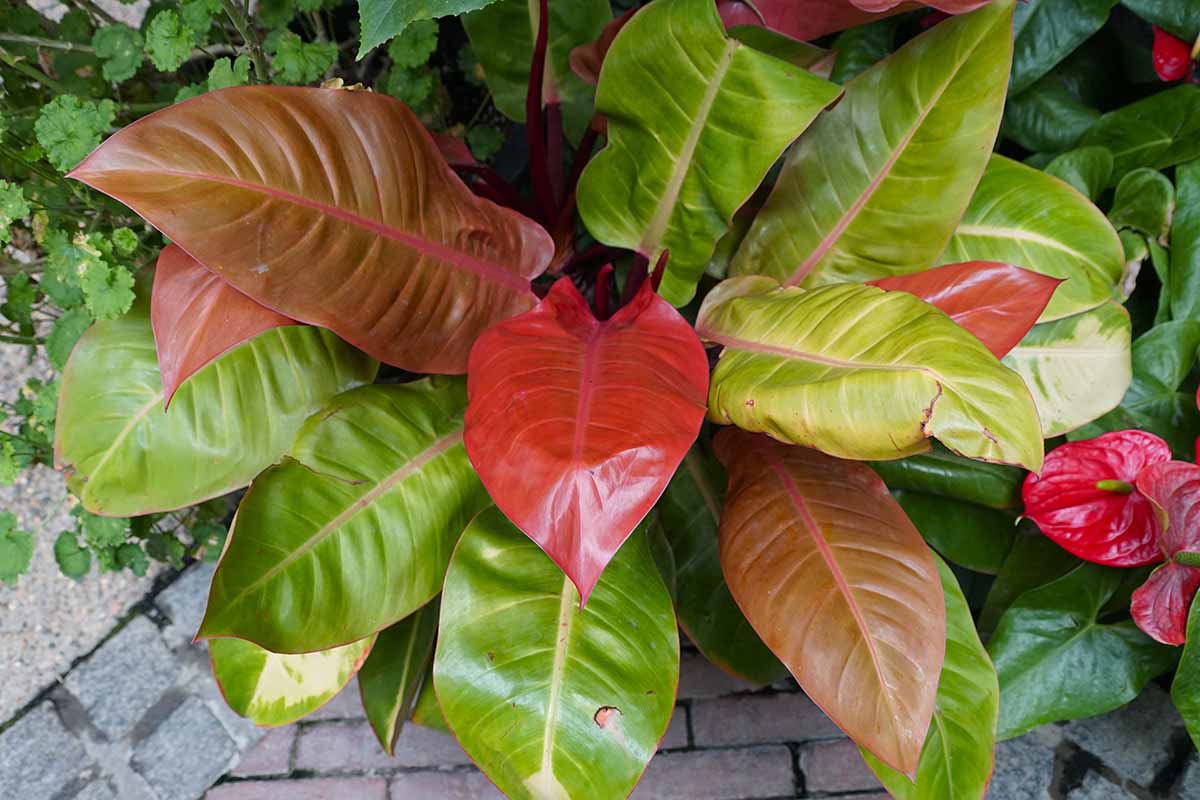
Depending on the light conditions, the color might trend more red or more yellow, and the leaves mature to green as they age.
That means on one three-foot-tall, self-heading plant, you will have a range of colors like a sunset wrapped up in a plant.
You can pick up a starter plant from the Hirt’s Garden Store via Amazon.
34. Ring of Fire
‘Ring of Fire’ has to be seen to be believed.
The lanceolate leaves are variegated hues of dark green and cream or yellow, with large, jagged sections of red and orange reminiscent of flickering flames.
The striking appearance is only enhanced by the saw-like rippling on the margins of the foliage.

This jagged edge forms on mature leaves, but young leaves have smooth margins, all on an eight-foot-tall plant.
We aren’t entirely sure how this hybrid was bred and by whom. Rumor has it that famous aroid breeder Keith Henderson used P. tortum and P. wendlandii to produce what was then called “Henderson’s Pride.”
If you’d like to enjoy this exceptional self-heading hybrid, you can find plants in four-inch pots available at Home Depot.
Because this plant is slow-growing, it might take a few years before you’ll be enjoying its full glory, but the wait is worth it.
35. Rojo Congo
‘Rojo Congo’ looks similar to its close relative ‘Congo Green,’ but it’s a bit smaller overall.
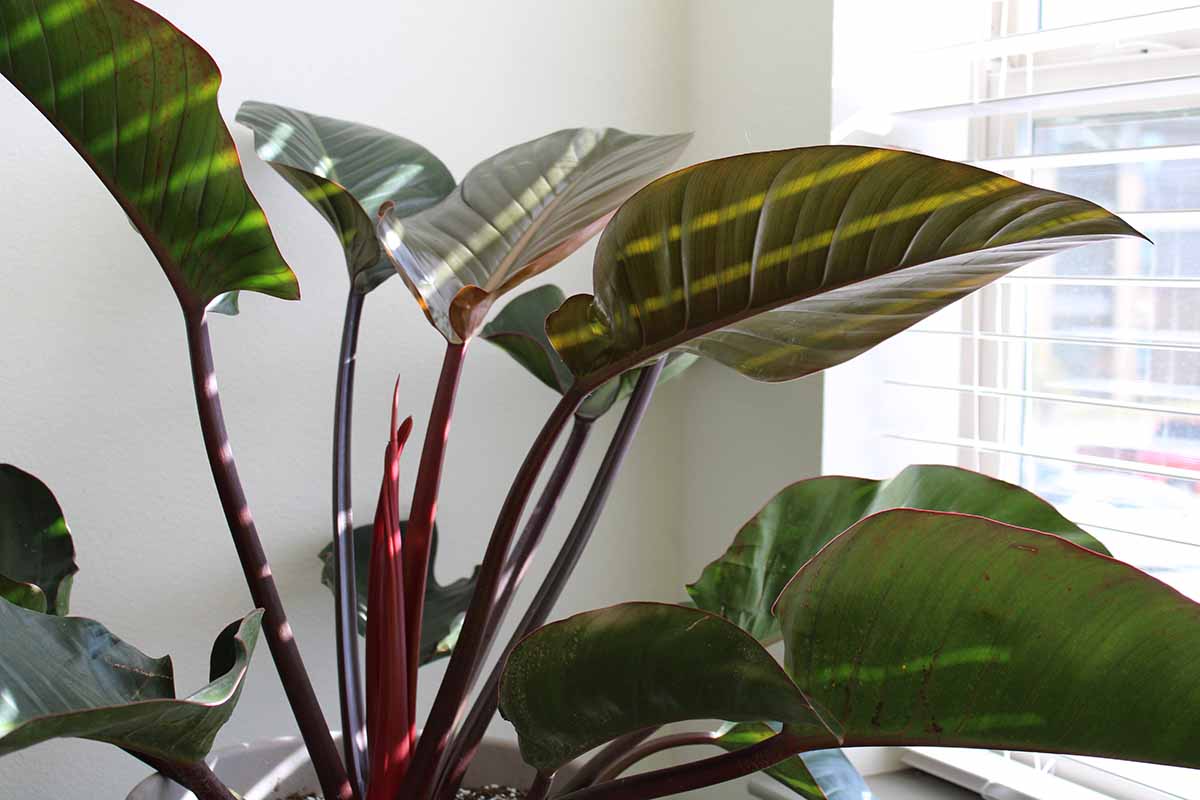
Sometimes called ‘Congo Rojo,’ it is a hybrid cross of P. tatei subsp. melanochlorum and P. x ‘Imperial Red’ that was bred in Florida in 1995 by Marian Wincenty Osiecki at Oglesby Plants International, Inc.
The petioles are burgundy or purple, and the leathery leaves on this self-heading type are thick and glossy.
You can find plants available from Planting Tree.
36. Silver Sword
P. hastatum is commonly known as silver sword philodendron, and it’s easy to see why.
The lanceolate or tri-lobed leaves, which are more arrow-shaped when they’re young, have a distinct shimmery silver hue.
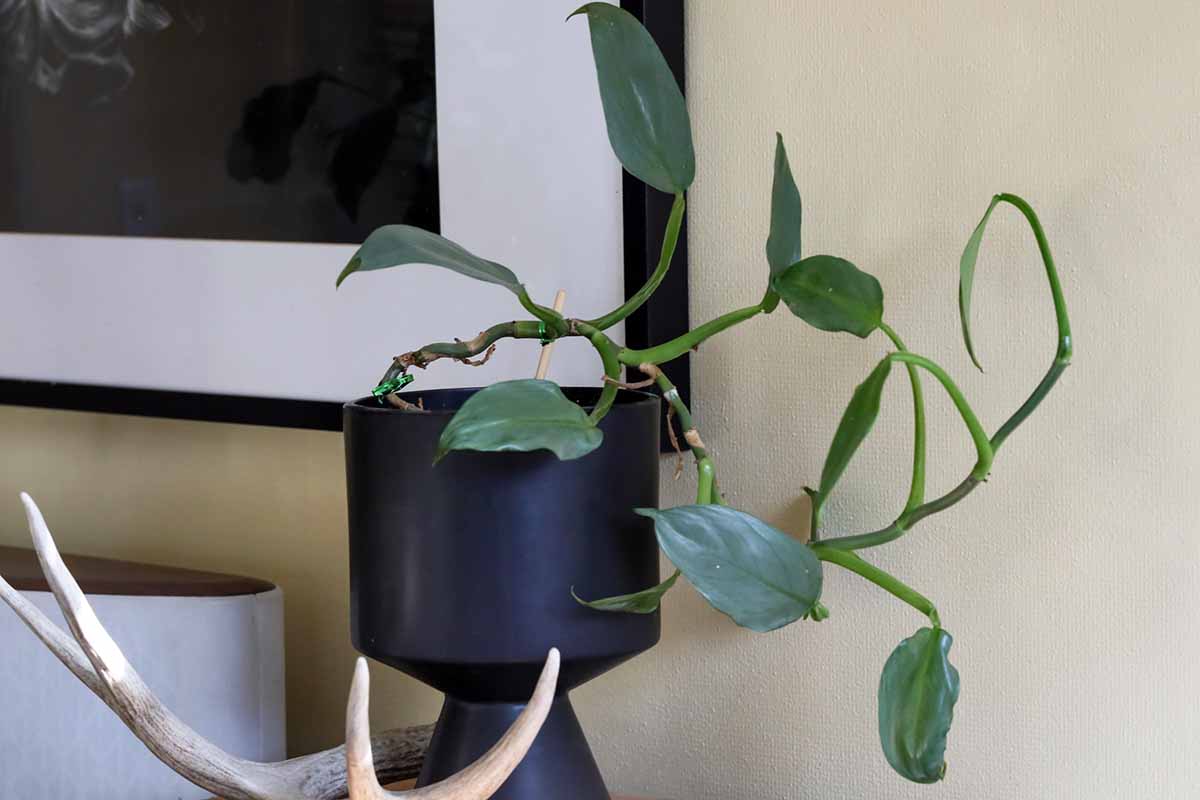
The mature leaves resemble a sword complete with a handle that, combined with the color, truly lives up to the name.
Train this climber up a moss pole or let it crawl along a horizontal shelf.
Make sure you have enough room because it can grow 15 feet long in the home and 30 feet long outside. Either way, it’s a pretty cool plant.
You can find P. hastatum in seven-inch seagrass containers available at Home Depot.
37. Snowdrift
‘Snowdrift’ has a mysterious past. Philodendron enthusiasts strongly suspect that this hybrid was bred using P. pinnatifidum and P. giganteum as a white variegated version of ‘Jungle Fever,’ but no one knows for sure.
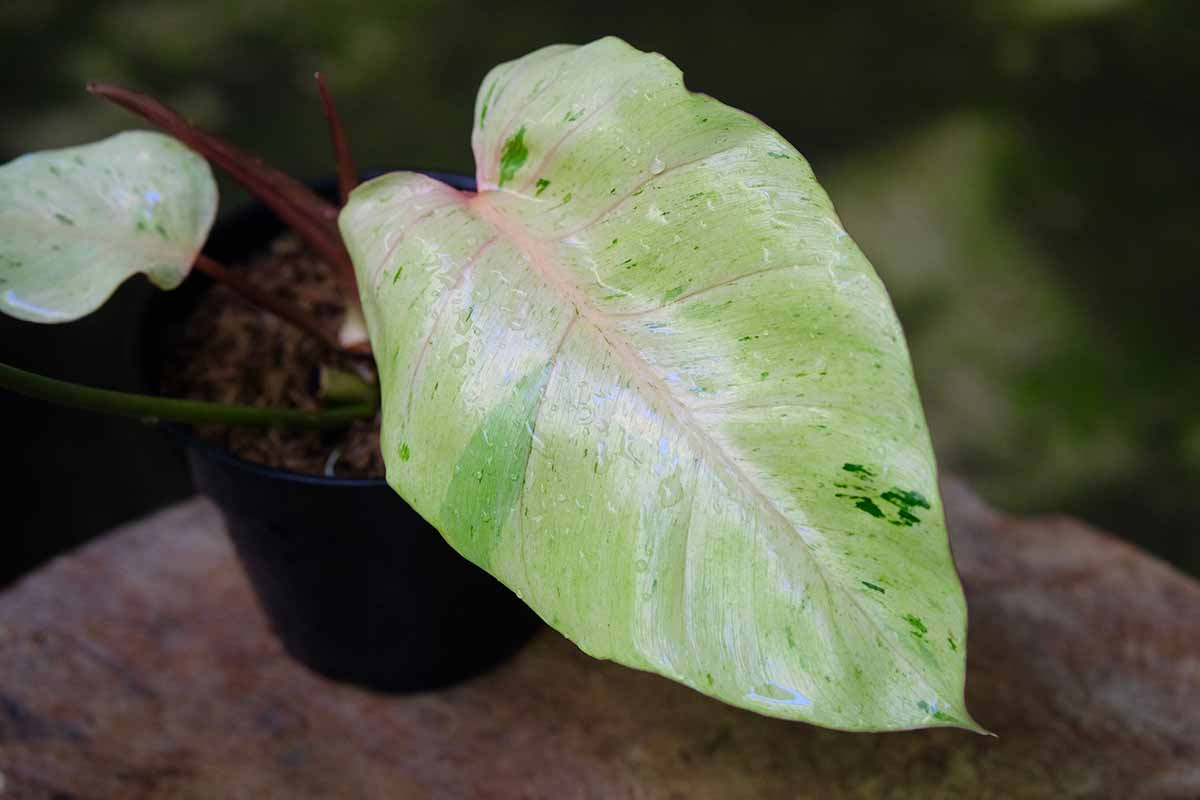
Regardless of how it found its way into our lives, this relatively slow-growing, self-heading type has heart-shaped, pinkish-white leaves that gradually mature to a grayish-green with flecks of dark green and white.
The pale foliage contrasts against the pinkish-red petioles and it’s a unique plant that has become highly sought-after.
It’s often mislabeled as ‘Jungle Fever,’ but that cultivar has yellow rather than white hues. Both grow to about three feet tall.
38. Summer Glory
Remember how I raved about P. gloriosum? Clever LariAnn Garner, research director at Aroidia Research in Homestead, Florida, bred a species plant with an unnamed Bob McColley cultivar.
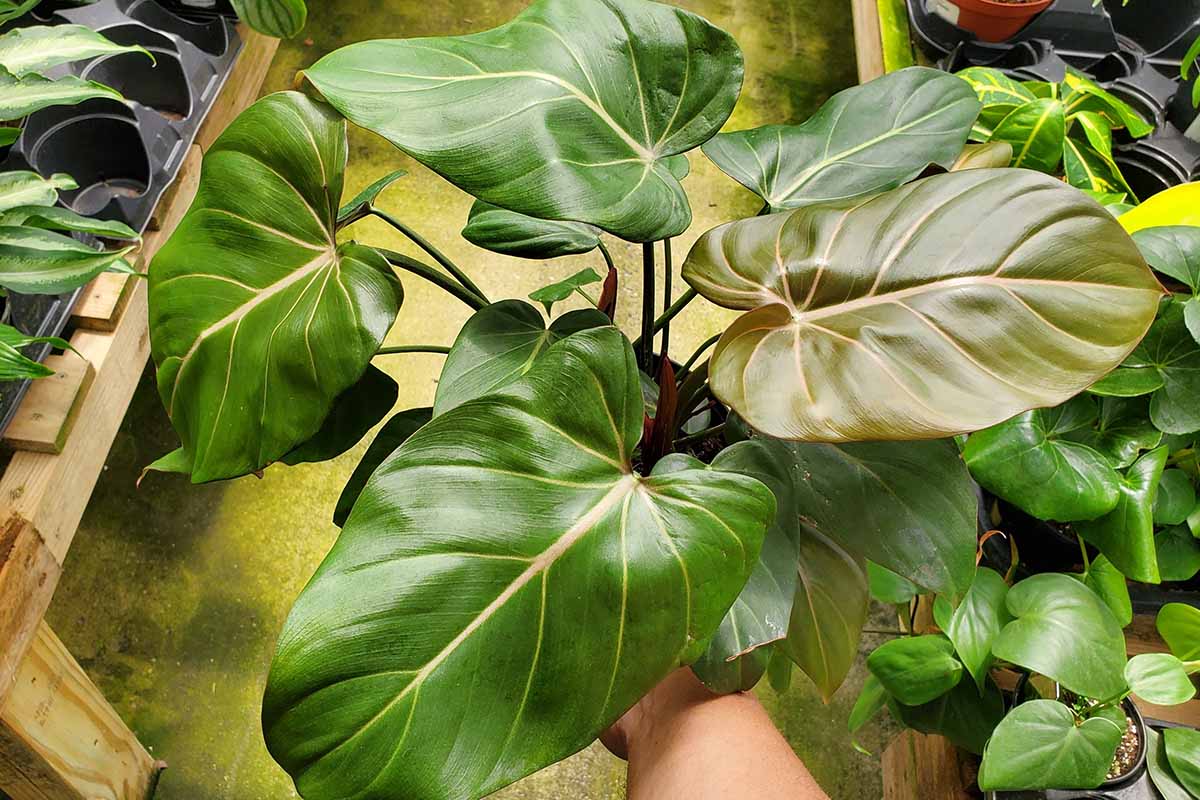
The result is ‘Summer Glory,’ with its semi-glossy, heart-shaped, deep green leaves with prominent white or light green veins.
‘Summer Glory’ has a red hue to the foliage and petioles. When the young leaves unfurl, they’re coppery pink.
The veins remain pink as the leaf turns solid green, though some will retain a blush red margin. It’s a self-heading type that will climb up to about eight feet indoors.
If you love gloriosum as much as I do but you’d like a little more color, ‘Summer Glory’ should be top of your list.
Run, don’t walk, to Walmart to bring home a four-inch live plant.
39. Verrucosum
If you prefer your philodendrons to be the vining type, but you love the look of the dark green, quilted, heart-shaped leaves of P. gloriosum, grab yourself a P. verrucosum.
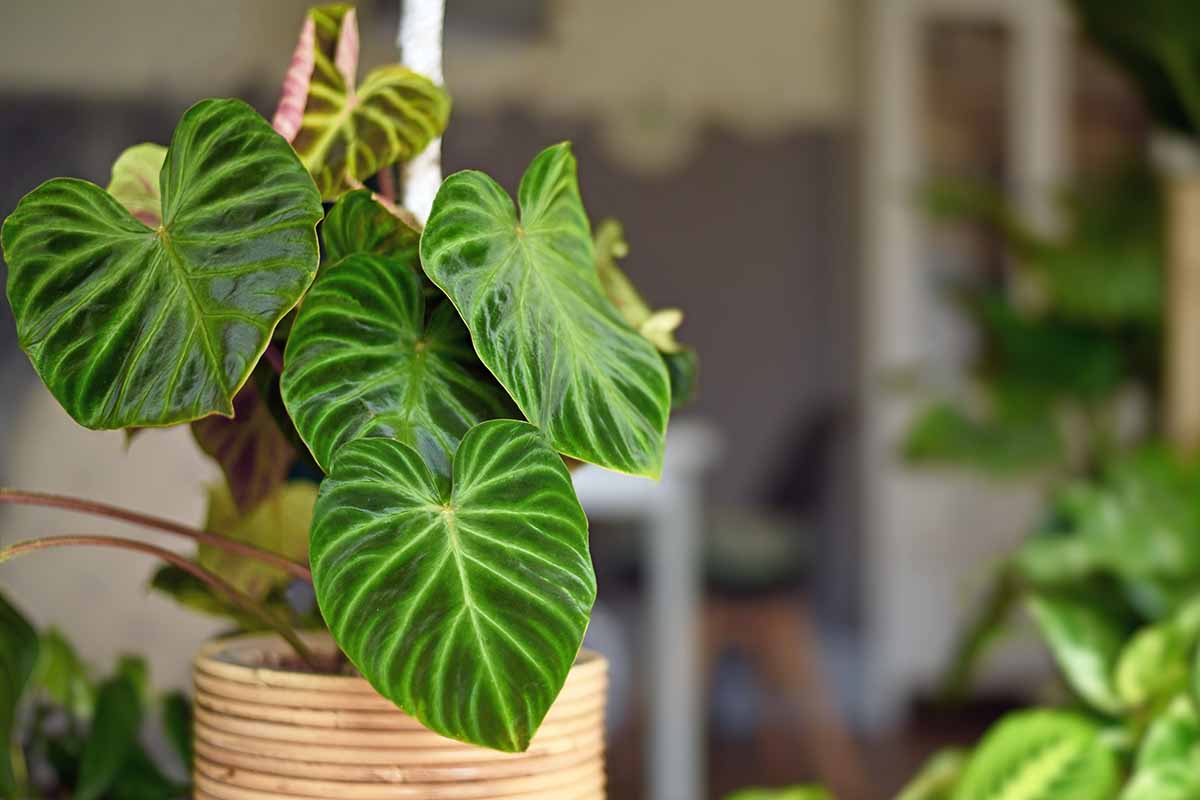
This climber or vining plant from South America has large, heart-shaped leaves with a velvety texture and burgundy underside, highlighted by light green to white veins.
Young leaves might even feature burgundy splashes.
Grow this in a hanging basket, trail it out of a container down a bookshelf, or give it a tall pole to climb. It will grow about three feet in length when mature.
You can find two-inch starter plants available at Home Depot.
40. White Princess
‘White Princess’ is the classic self-heading white and green variegated philodendron with white and pink stems.
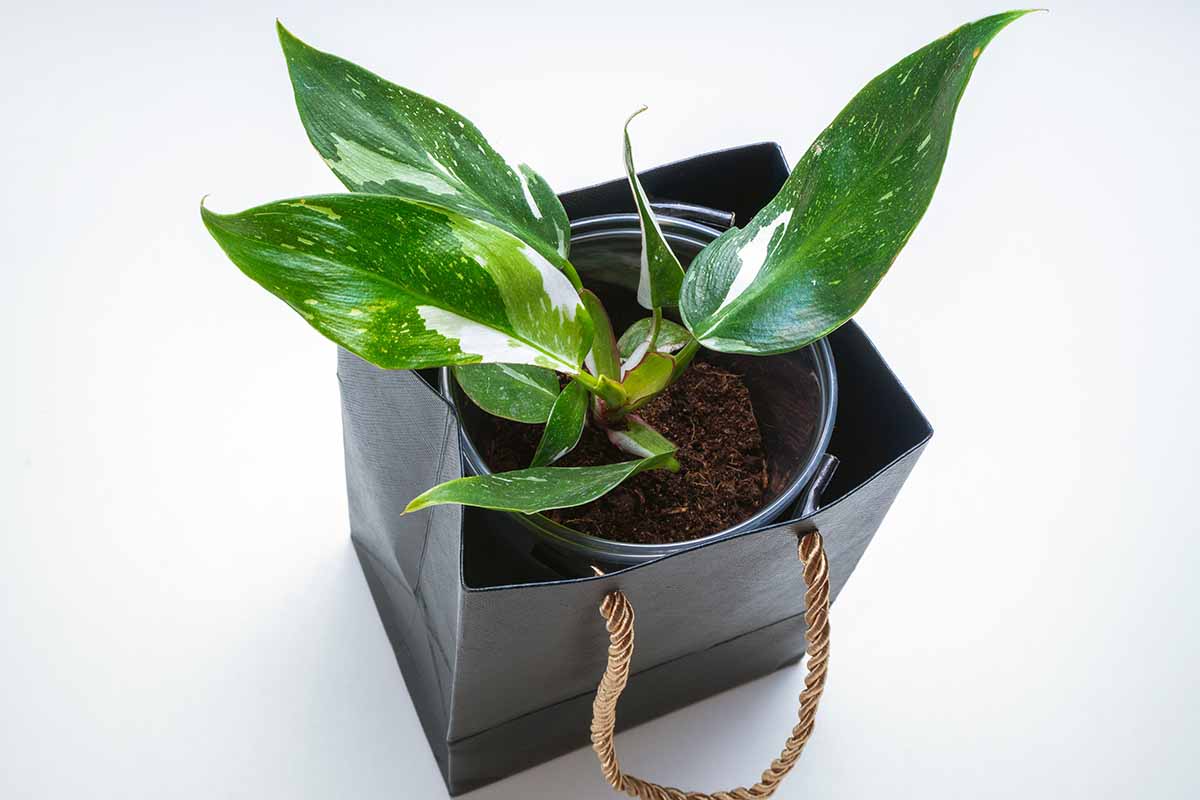
We know that this plant is related to P. erubescens, but it’s not clear whether it’s a hybrid, a cultivar, or a natural variation.
The leaves are lanceolate when young and gradually become more arrow-shaped as they mature. The plant can reach about five feet tall.
Pick up this fast-growing royalty in a two-inch pot from The Plant Farm via Walmart.
41. White Wizard
P. erubescens ‘White Wizard’ looks nearly identical to ‘White Princess’ but it grows more slowly and has green and white variegated stems.
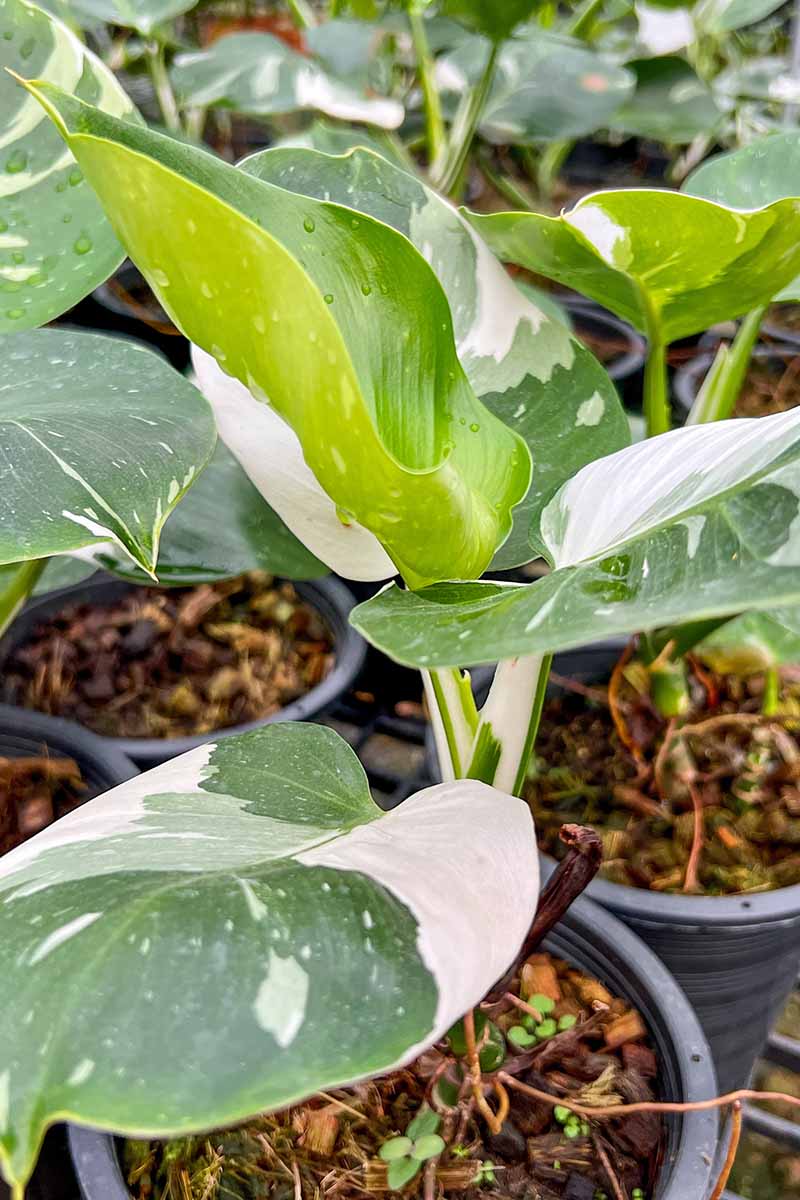
The leaves are also a bit larger when mature, and the white splotches tend to be bigger, as well. It grows to a similar size of three to four feet.
Nab ‘White Wizard’ in a four-inch nursery pot from Wekiva Foliage via Walmart.
Betcha Can’t Have Just One
Plant collectors know the feeling – you discover a beautiful hybrid and then another, and suddenly you’re knee-deep in fickle foliage that takes up all your free time.
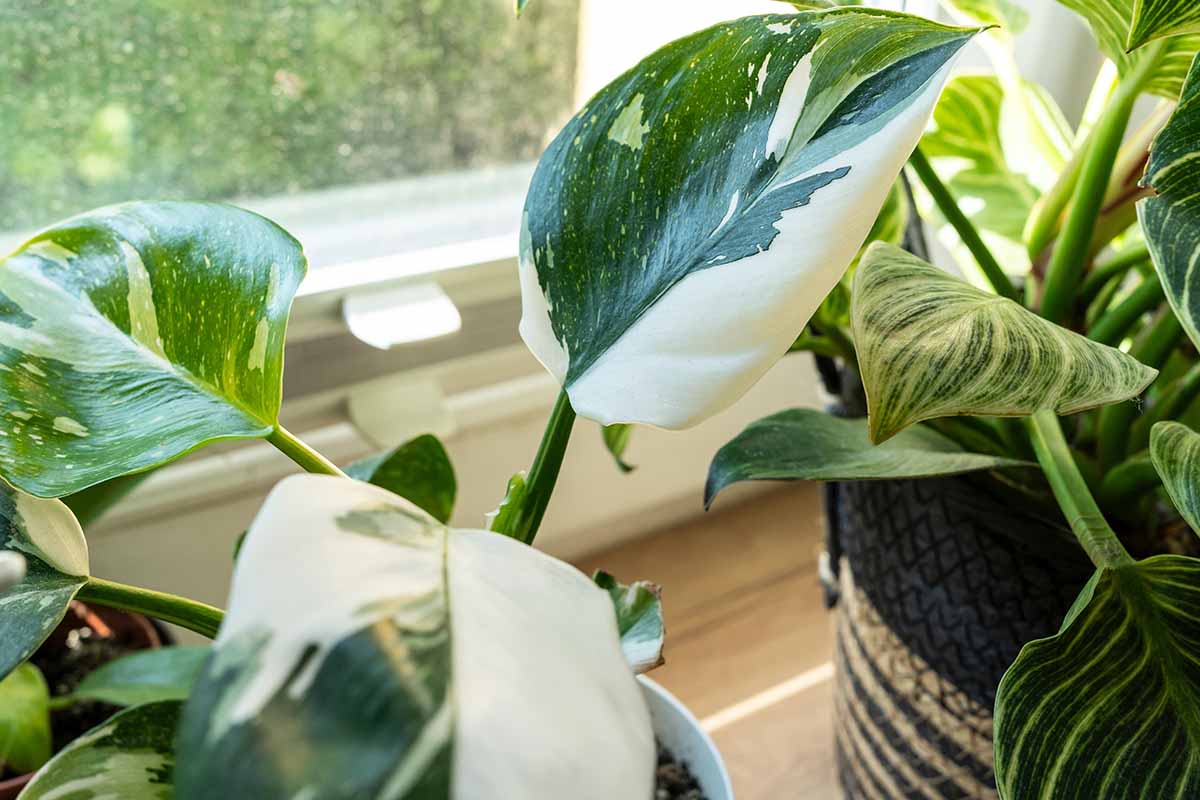
Not philodendrons! The collecting part is true, there’s always a cool new cultivar coming out, but most of these plants are so simple to care for that you can keep adding new ones to your collection without dedicating your life to their health.
Which plants on this list appeal to you? Did I miss one of your own favorites? Let us know in the comments section below!
And for more information about growing philodendrons, have a read of these guides next:
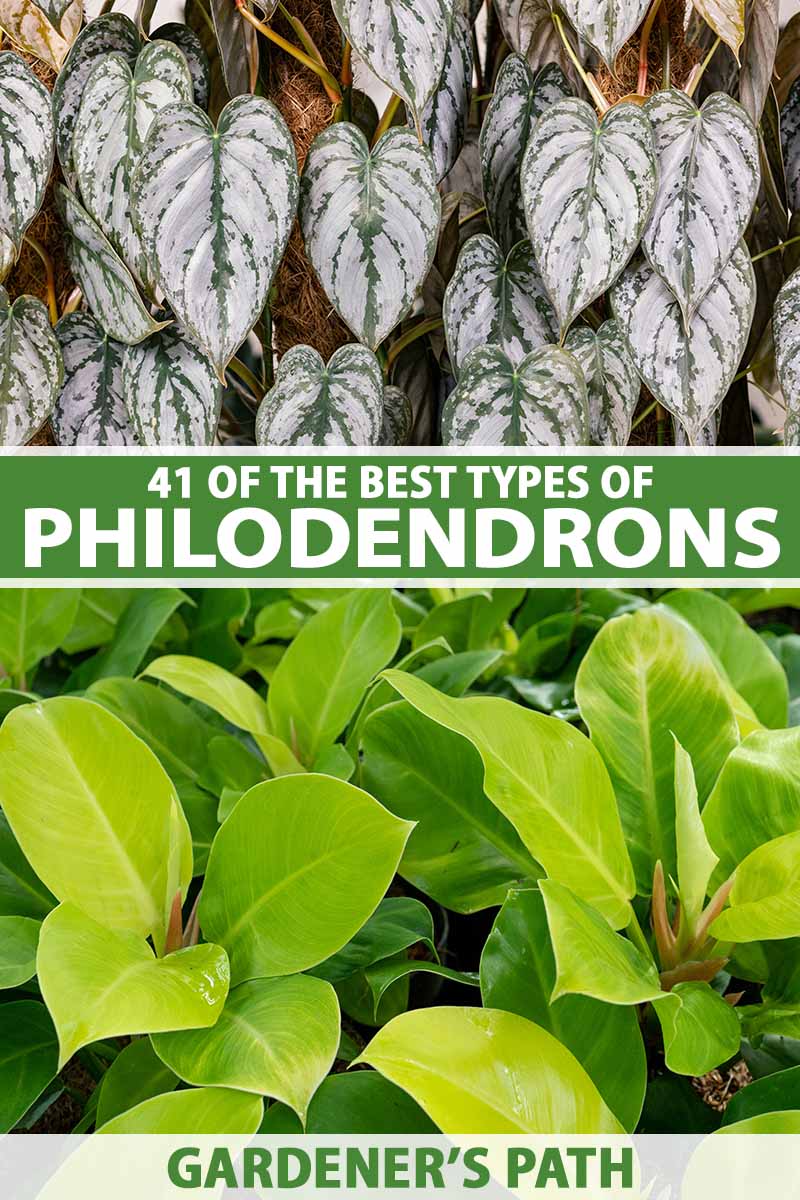
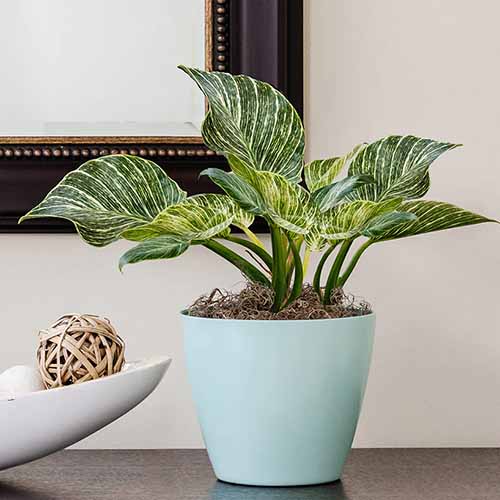

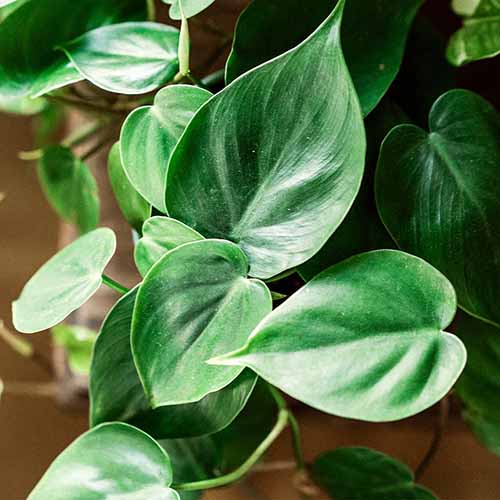
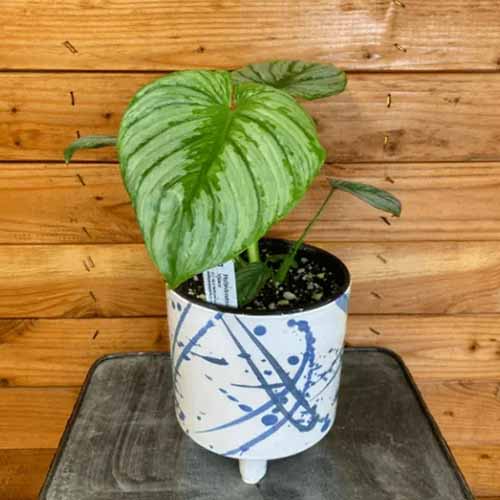
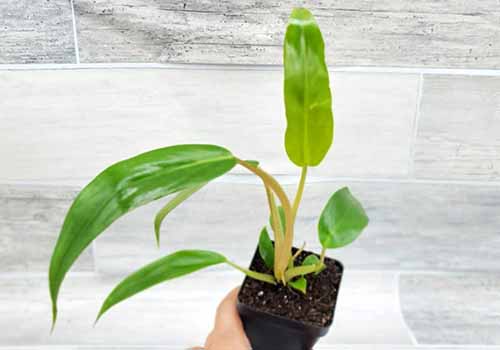
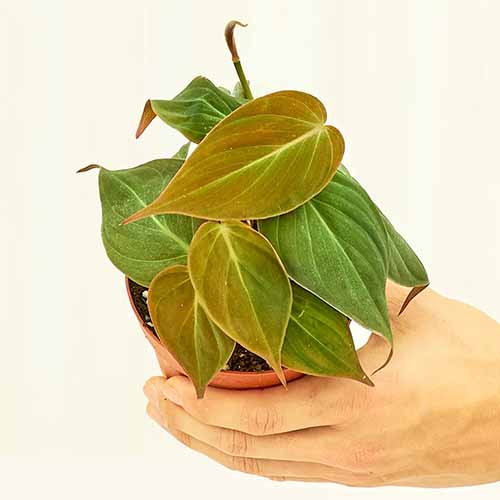
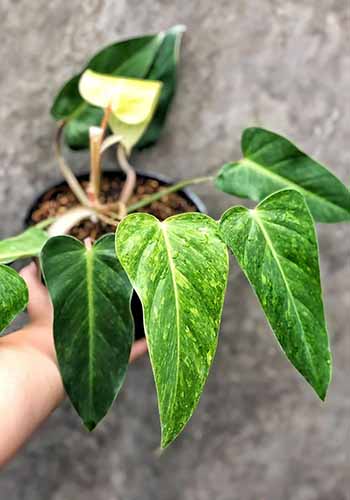
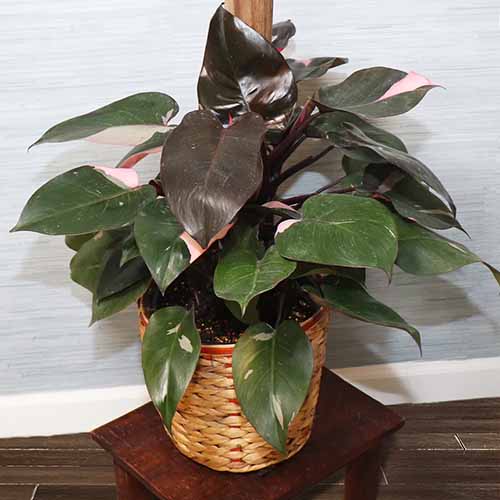
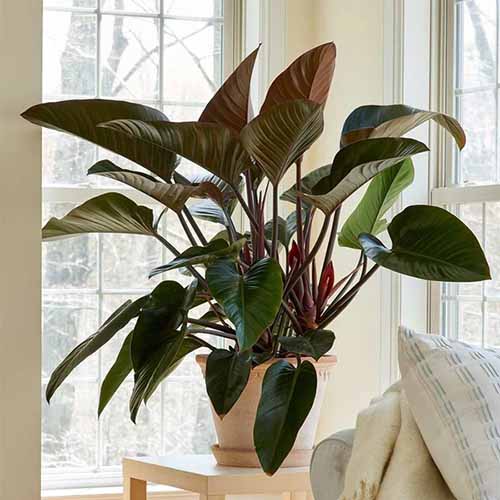
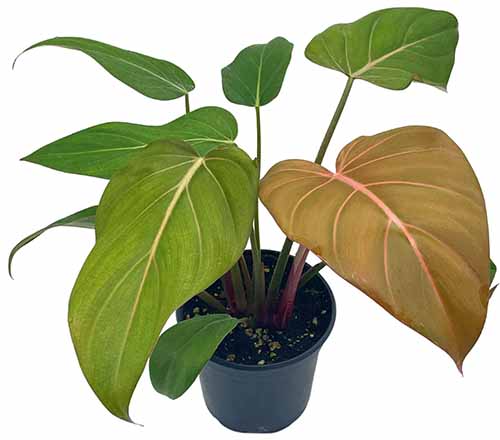
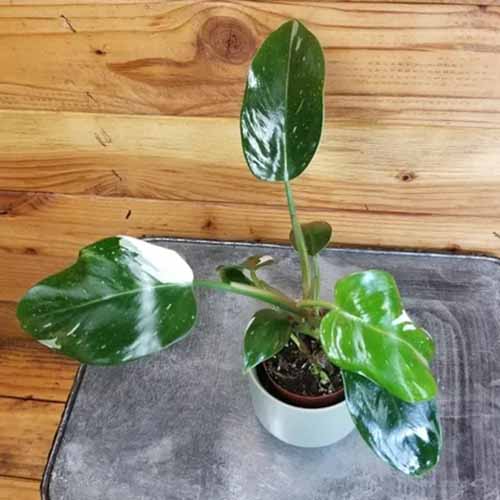
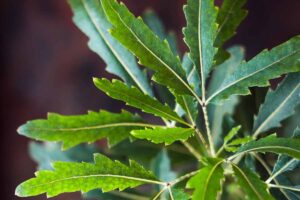
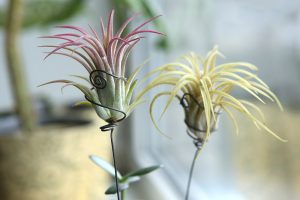

Hi Kristine! I have a philodendron I don’t see on your list. The last one is closest (the “White Wizard”), but the leaves do not have specks throughout. Mine has blotches of cream against a light to medium green background, the leaves are heart-shaped, relatively small, and with a matt finish.
Hi Alane, it’s hard to identify for sure without being able to examine the plant further, but this looks like an ‘N’Joy’ philodendron to me. They can be white or cream, depending on the light. At the same time, ‘White Wizard’ can sometimes lack the spotting in low light.